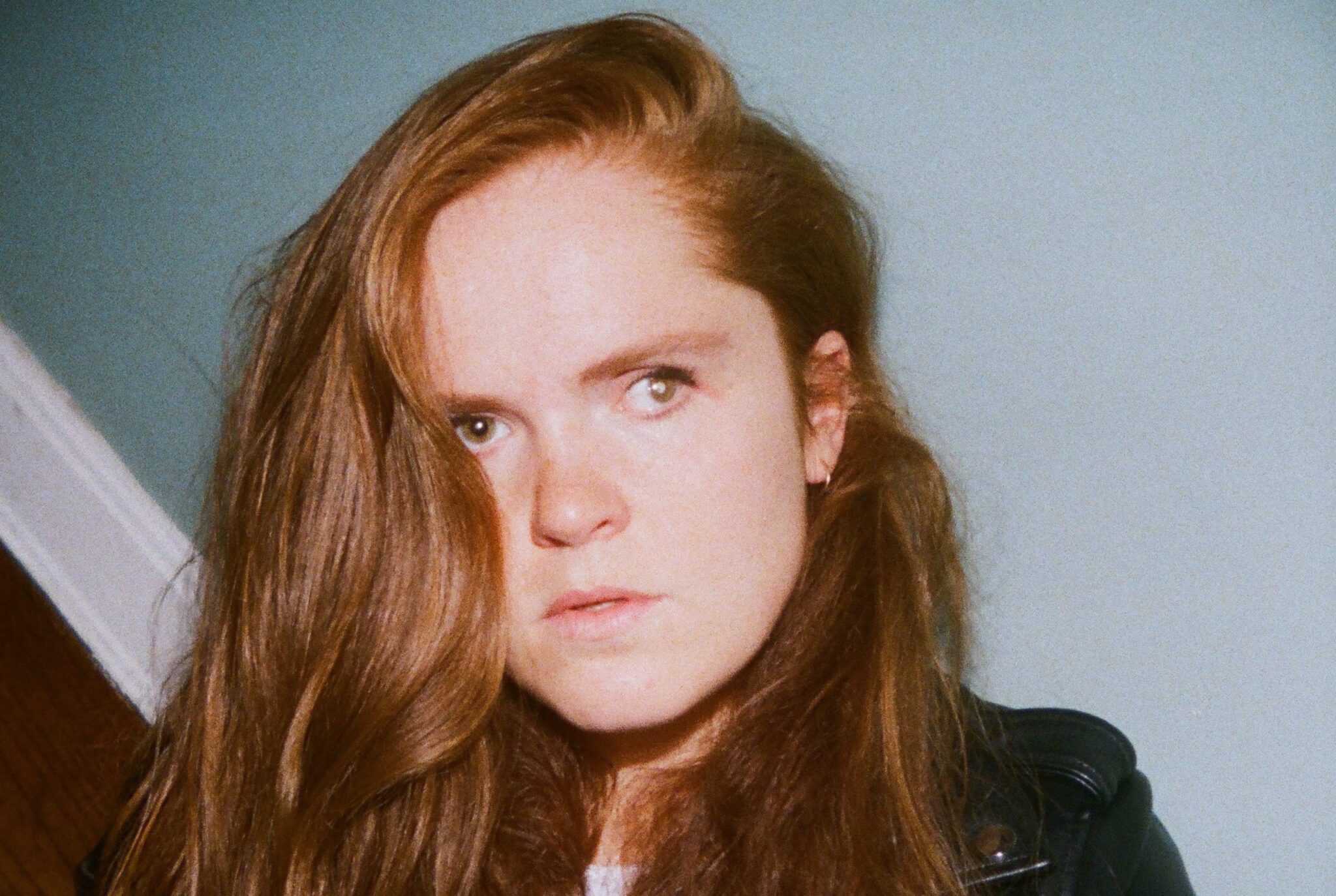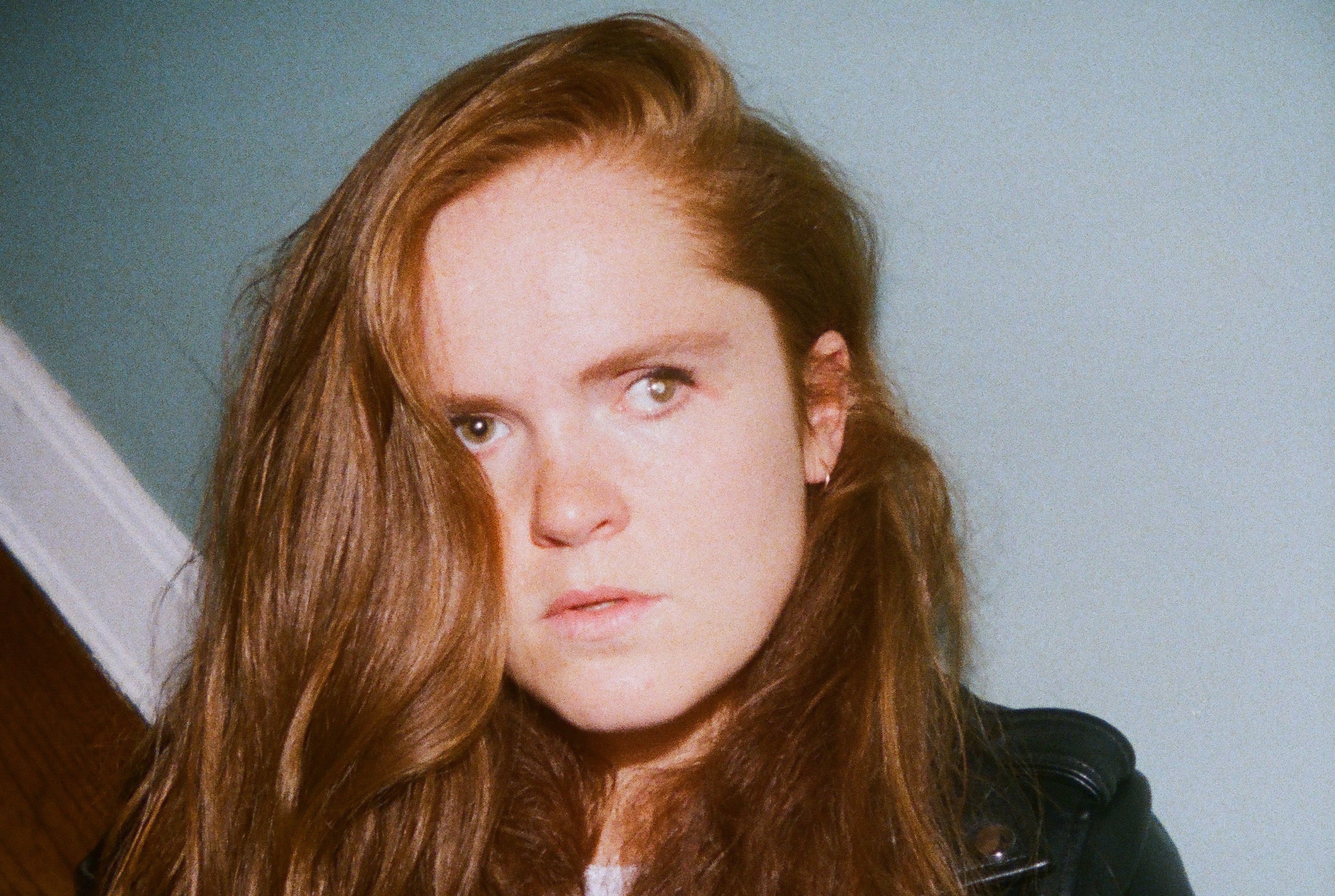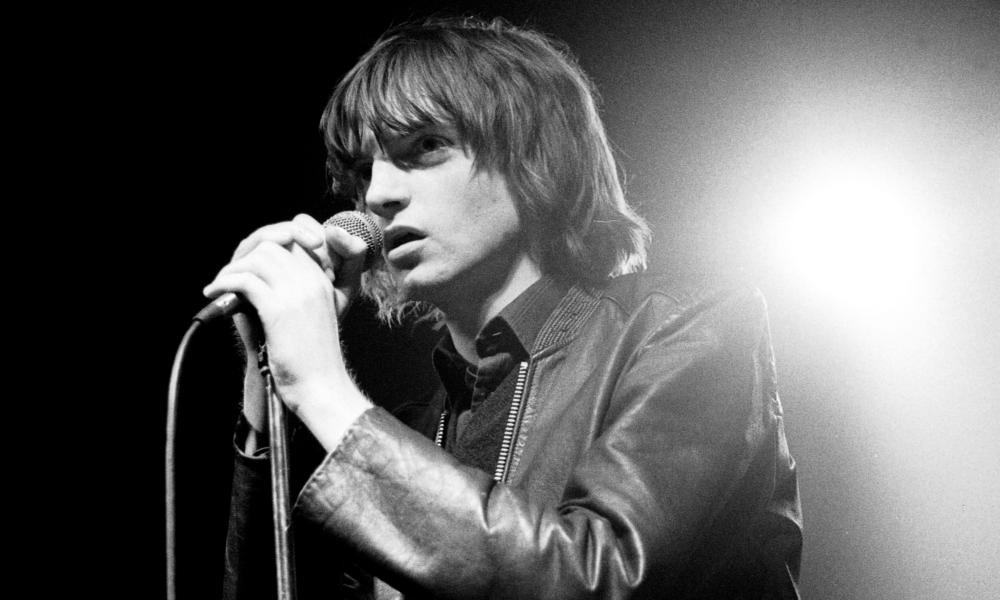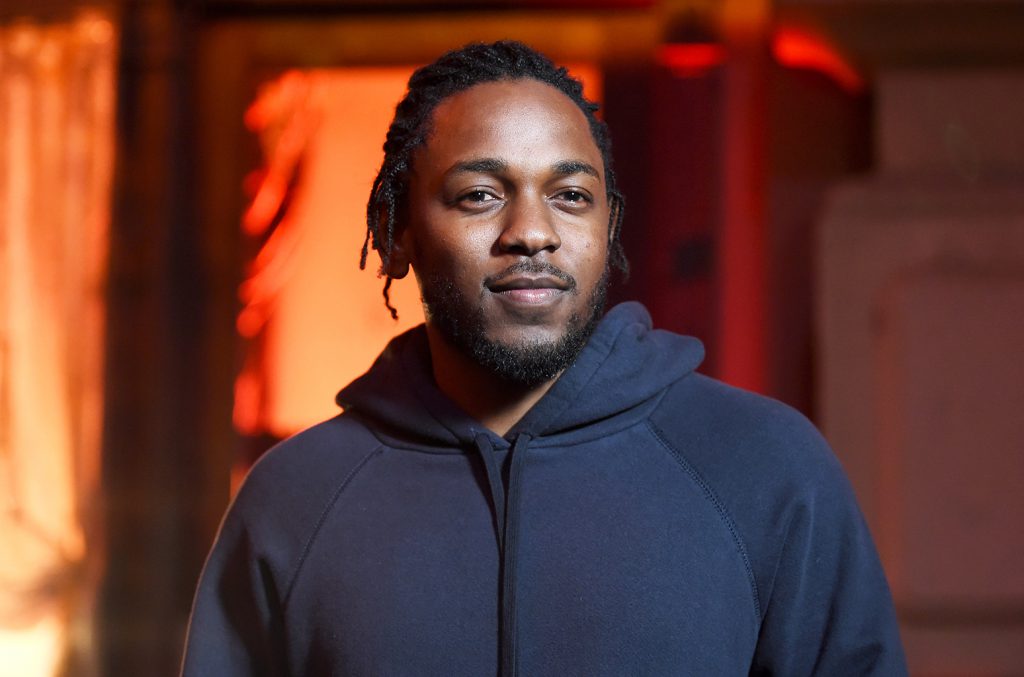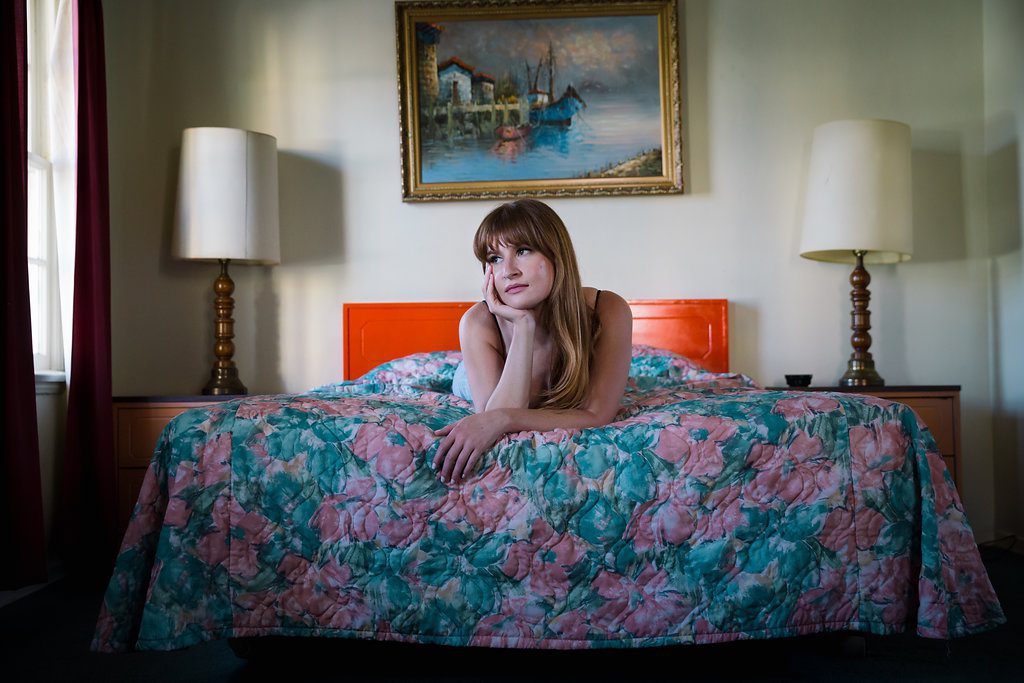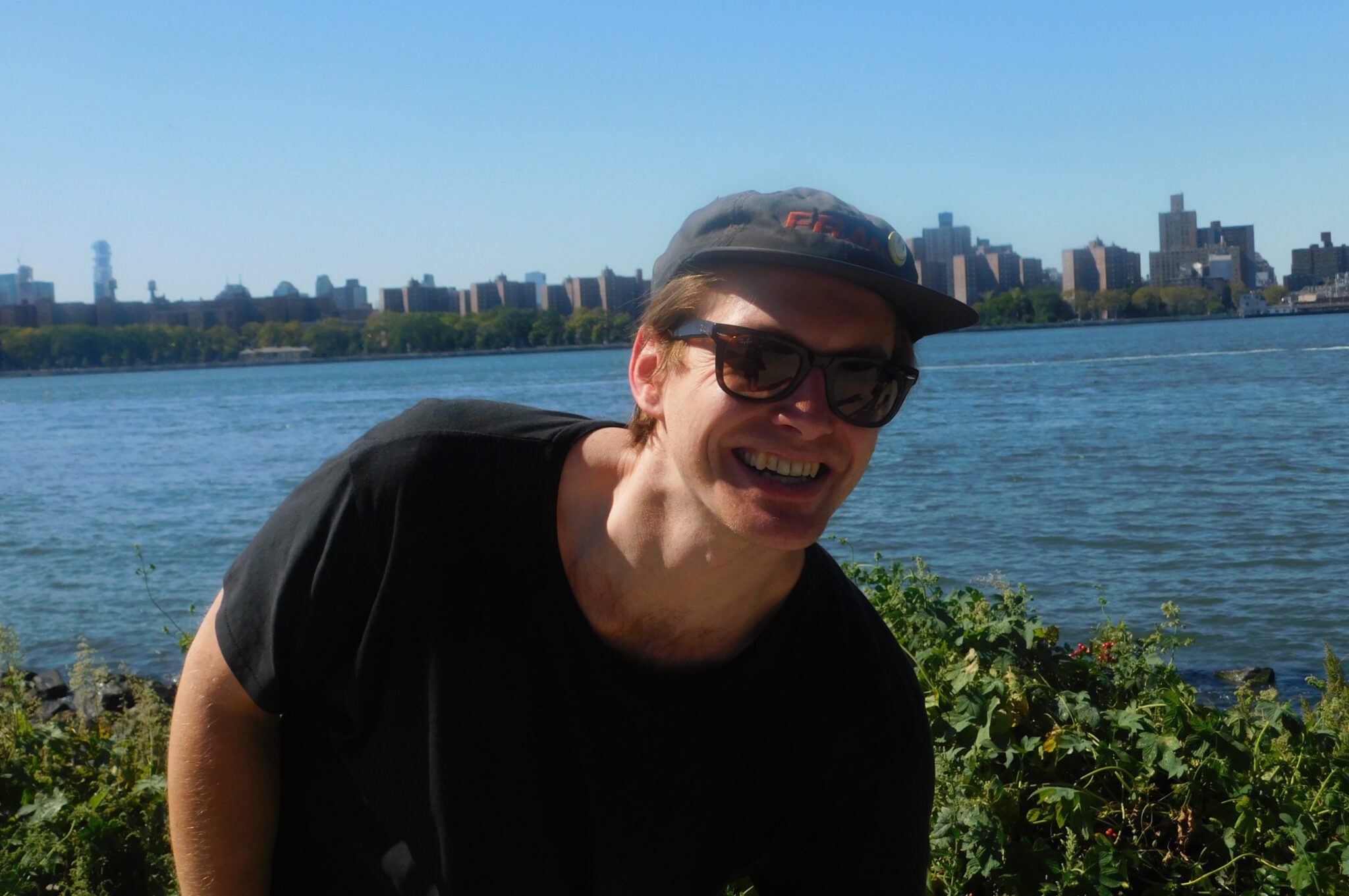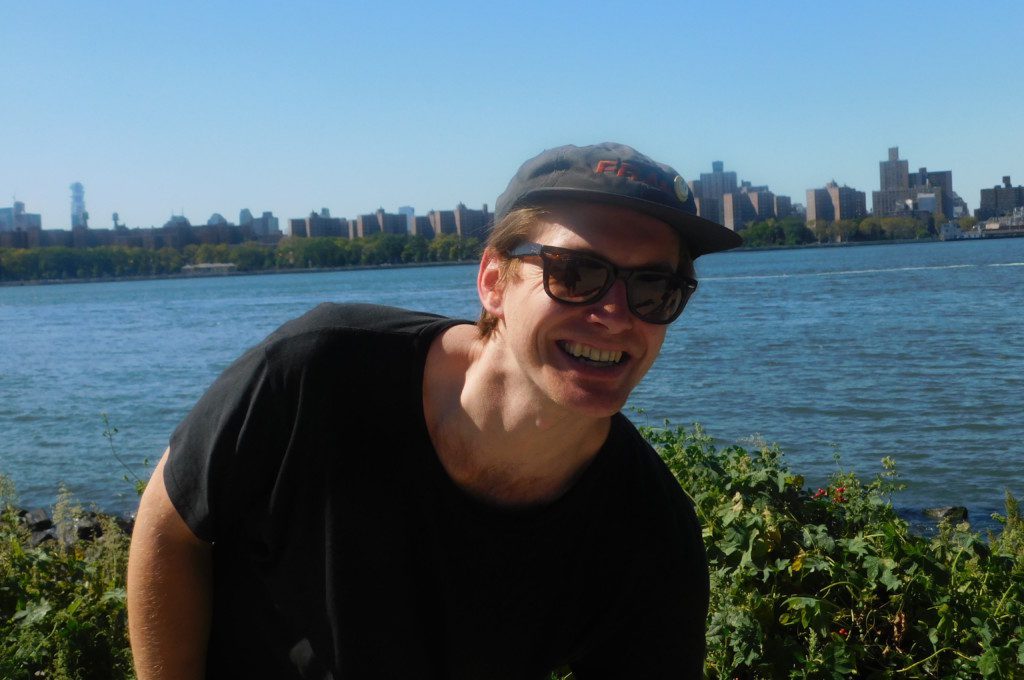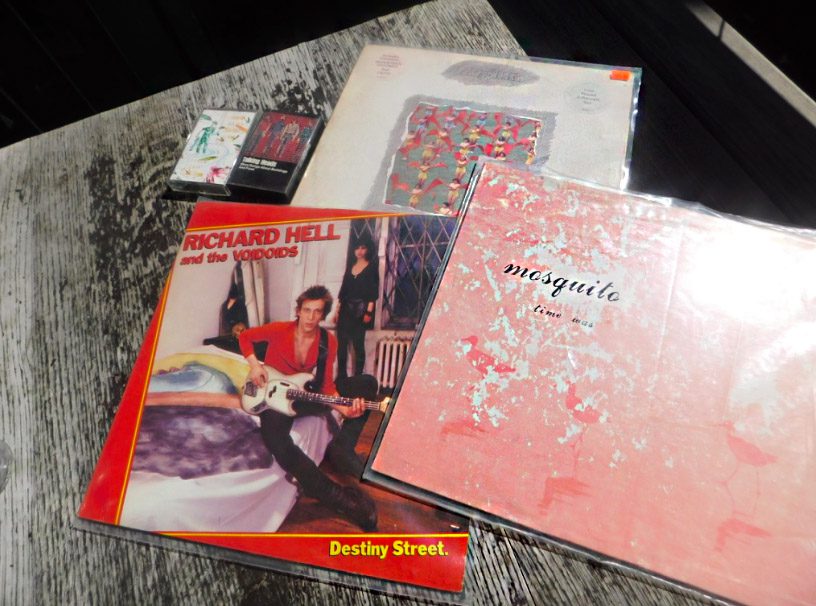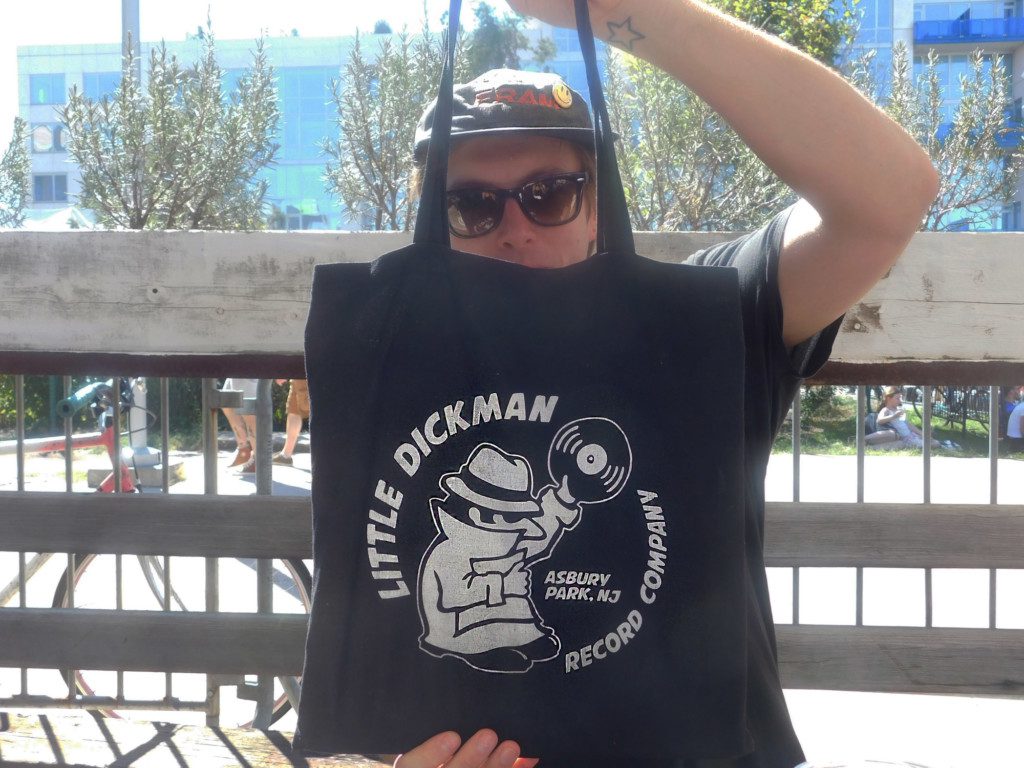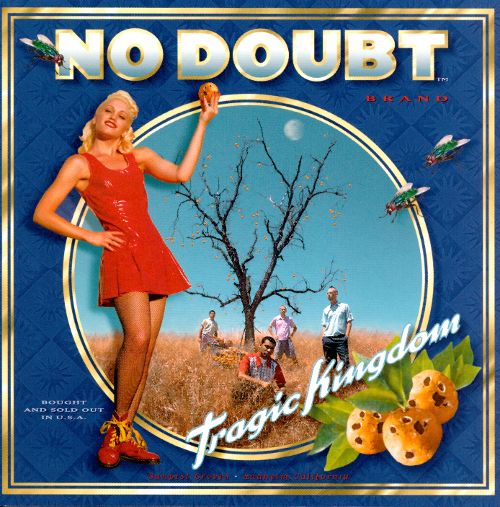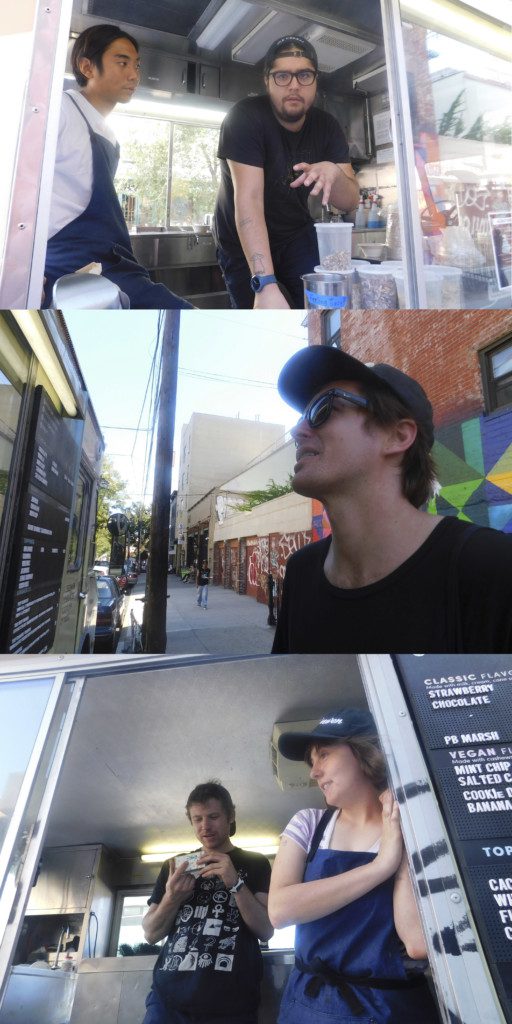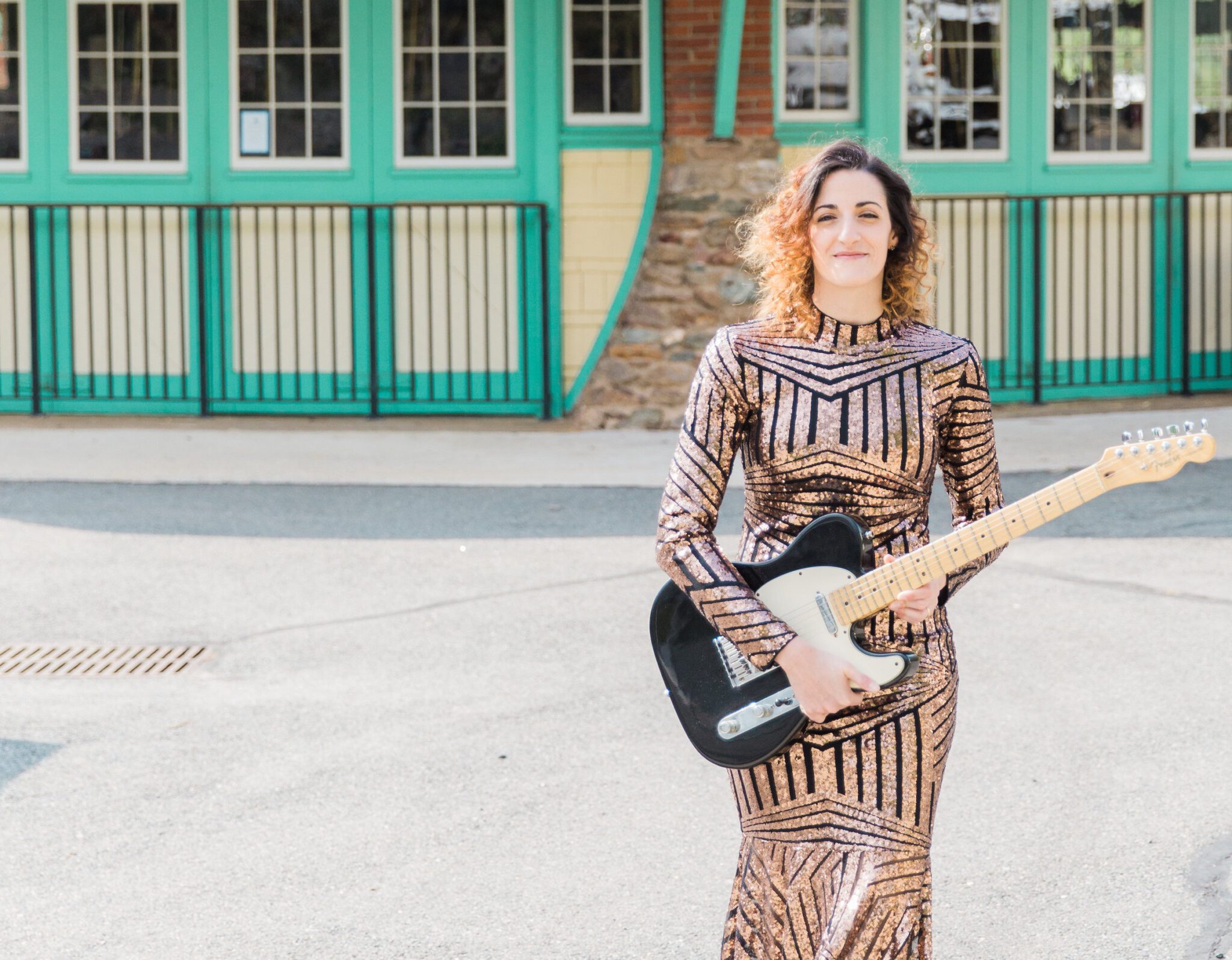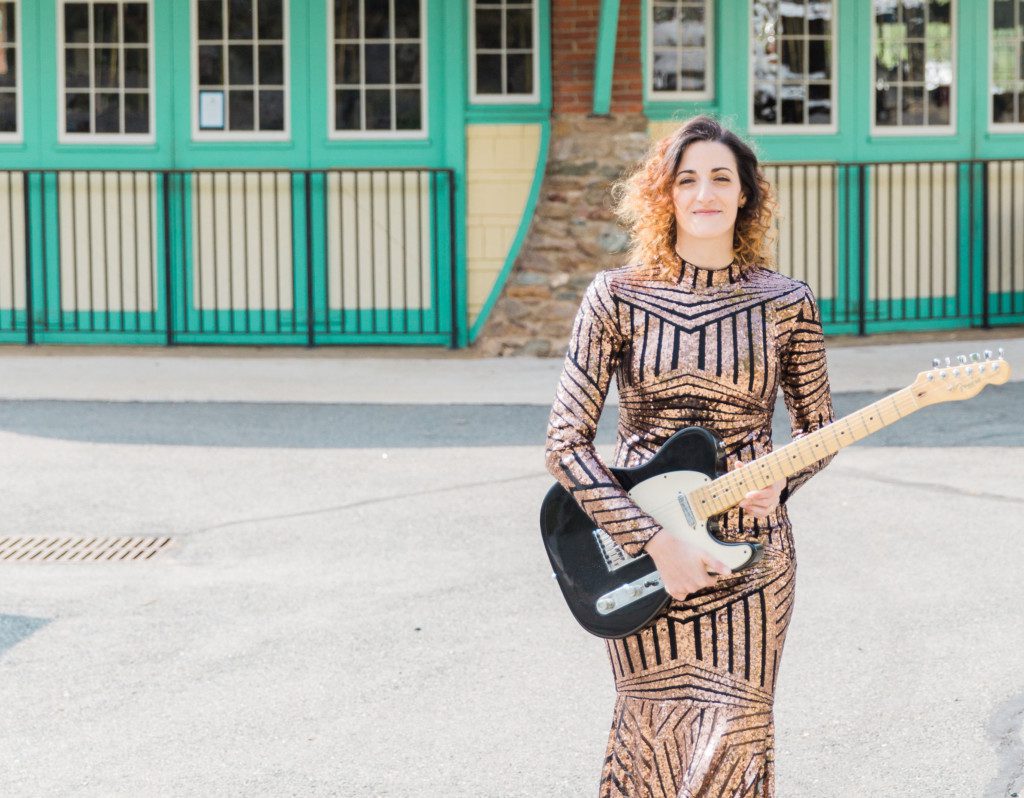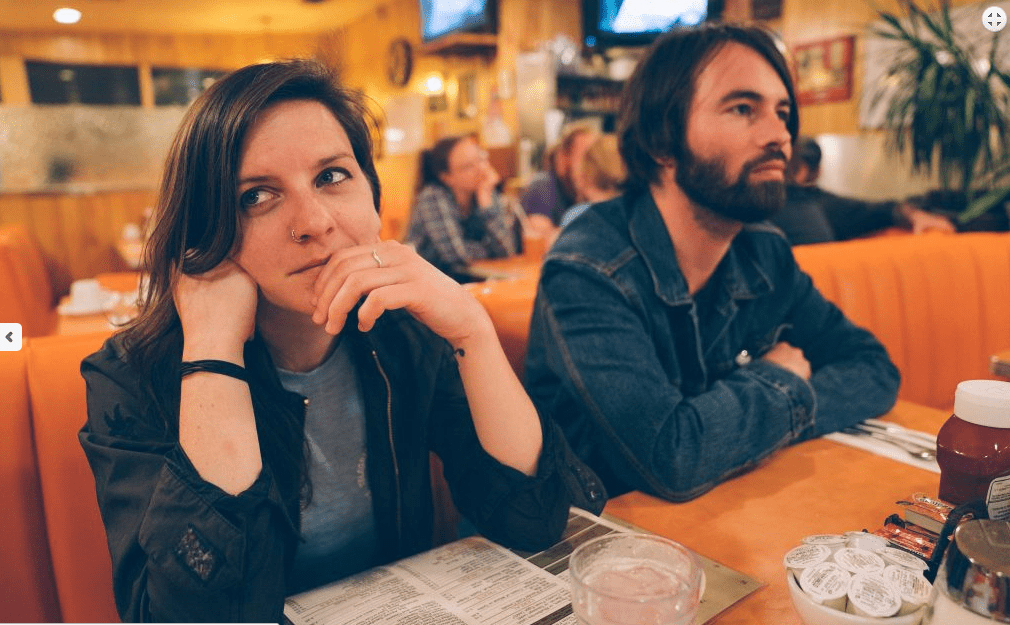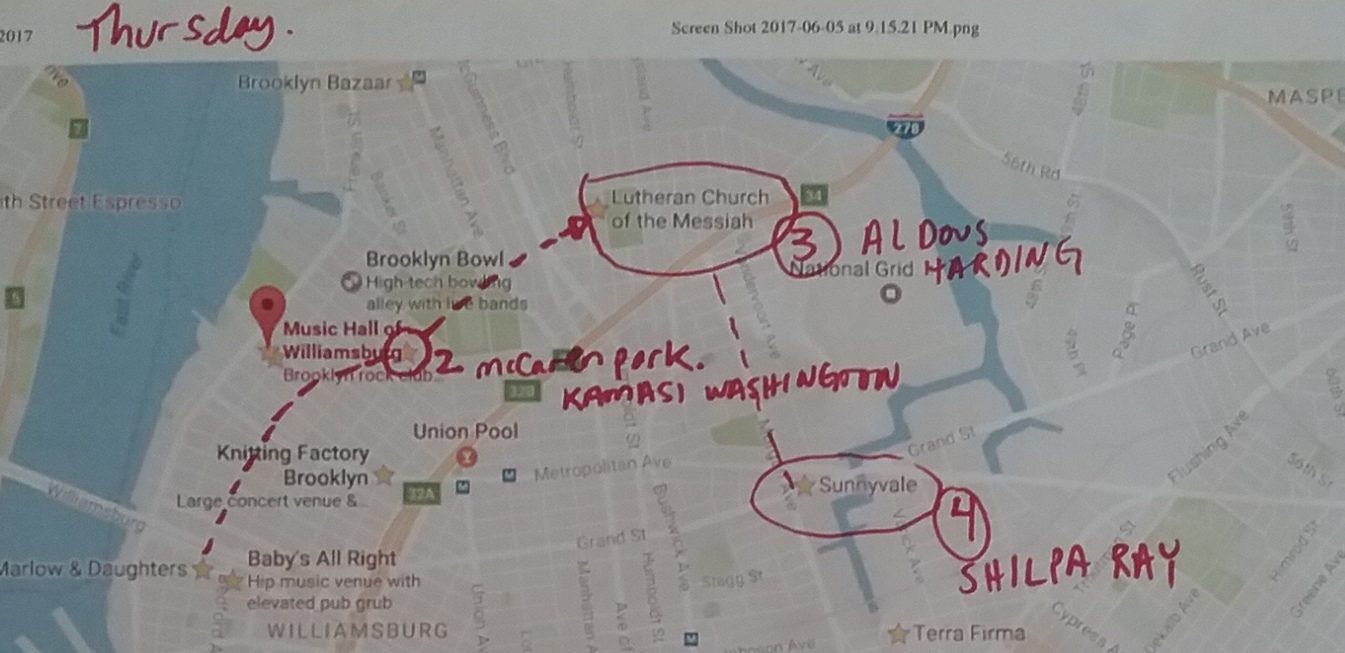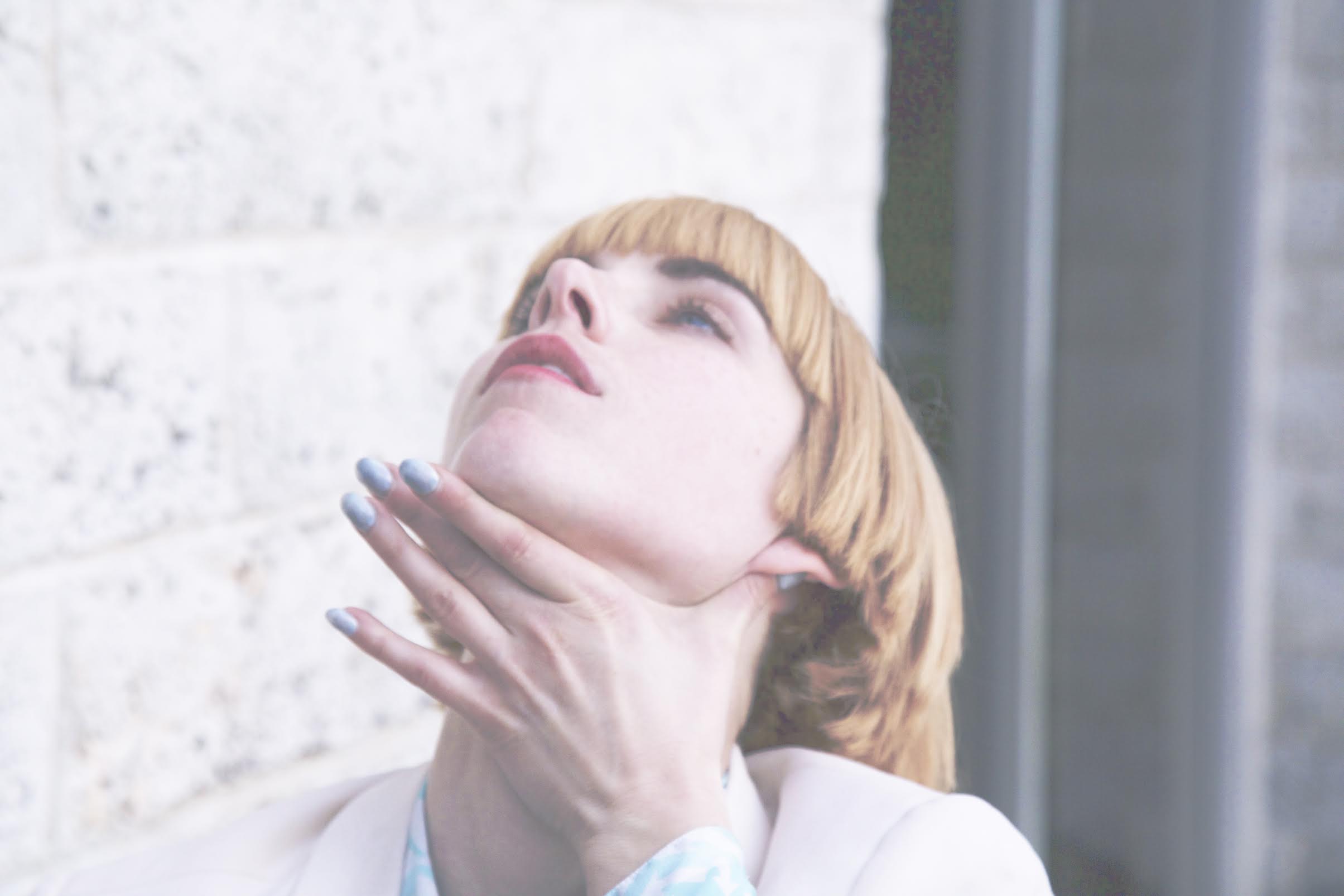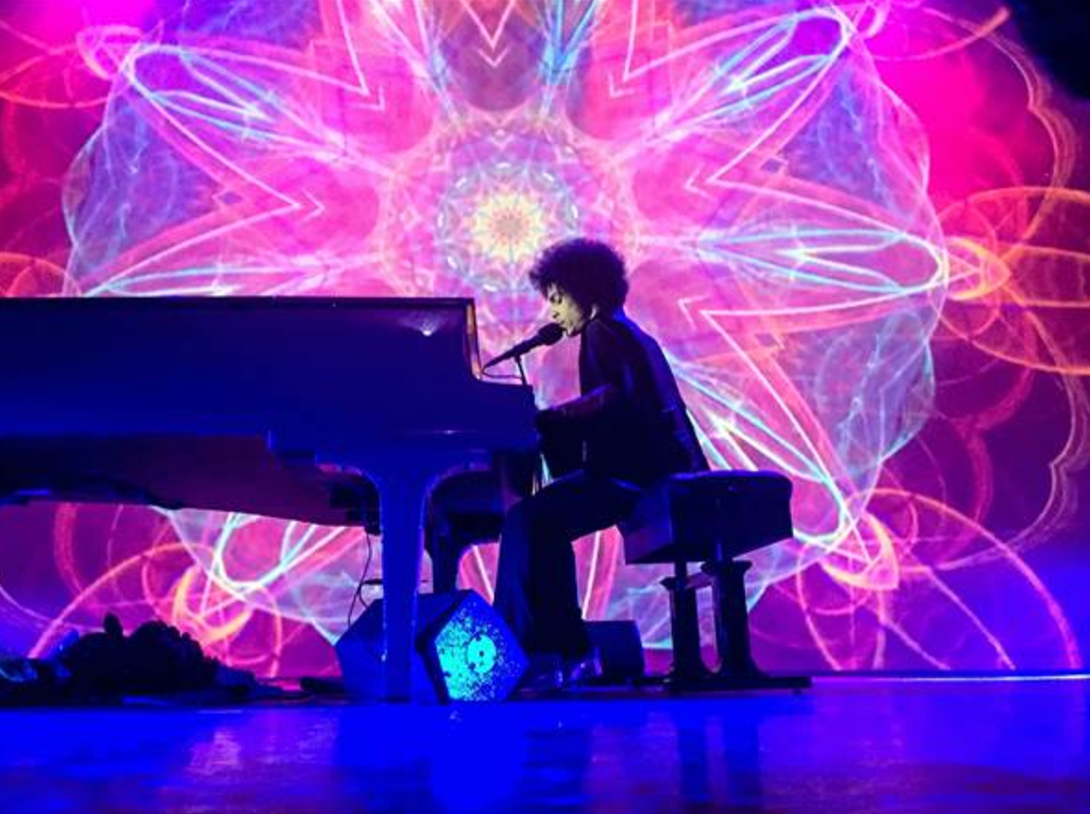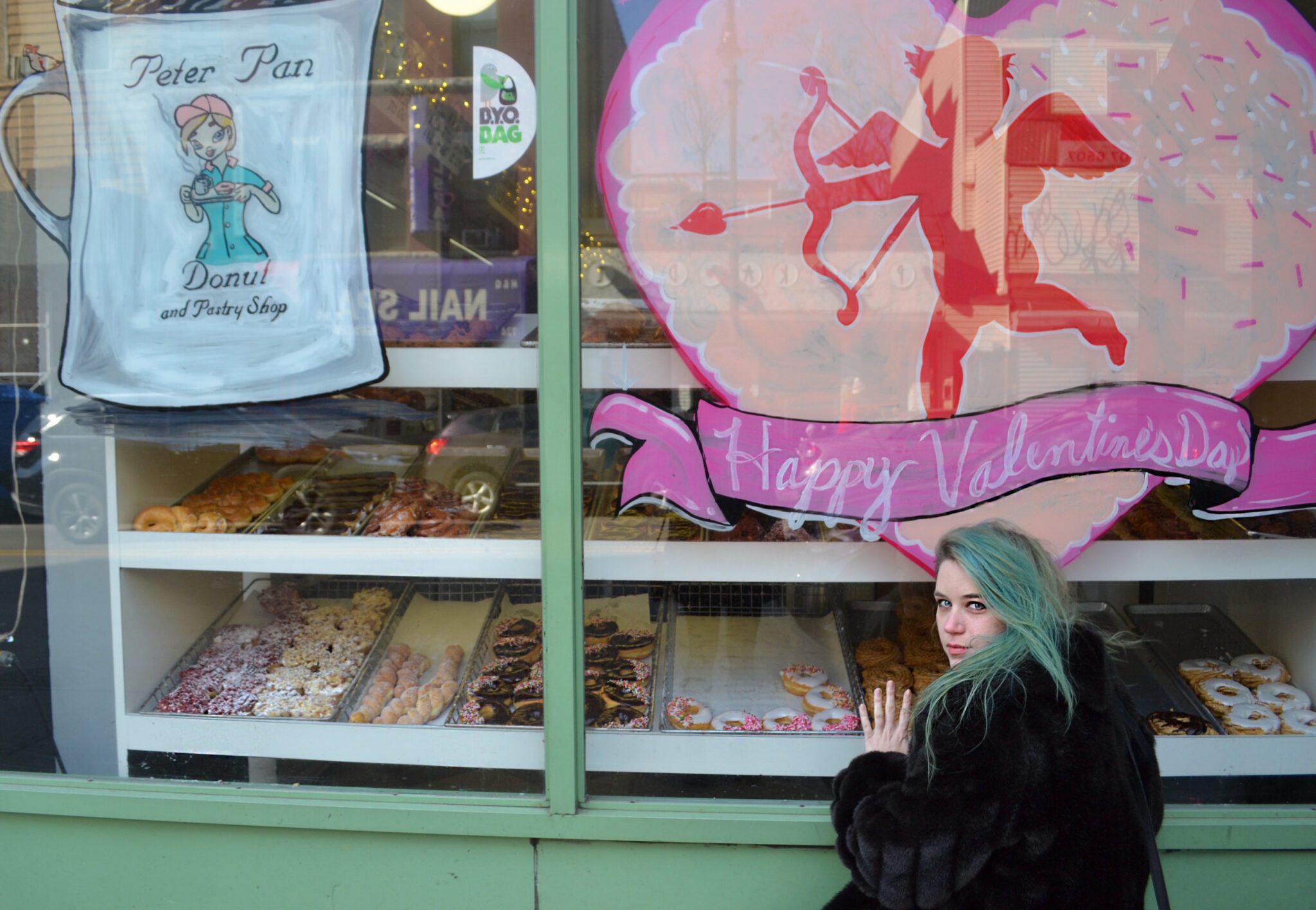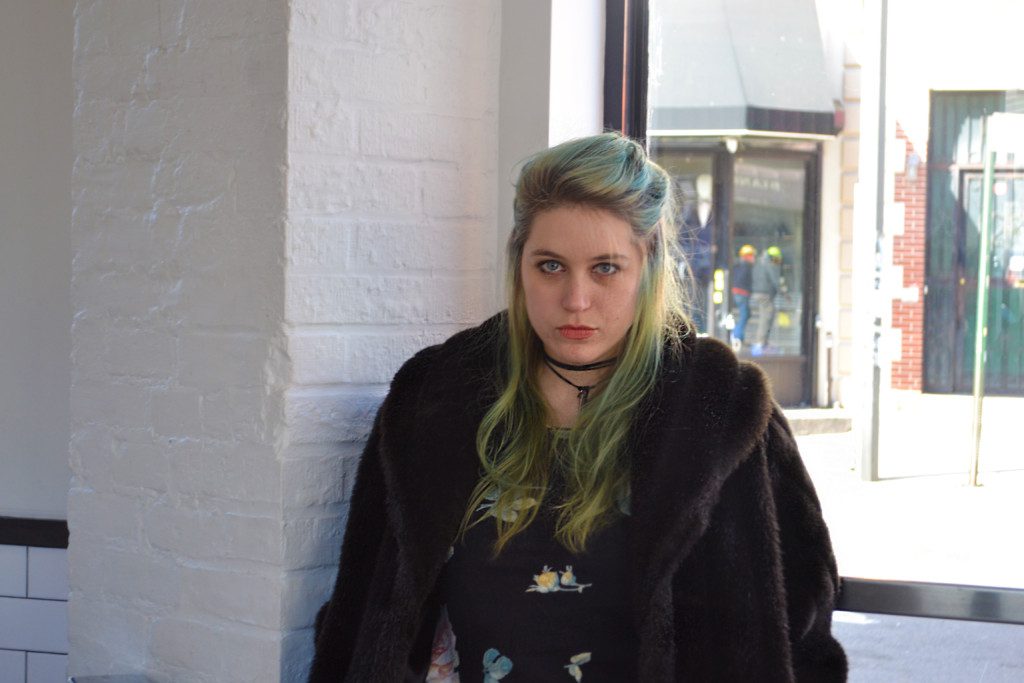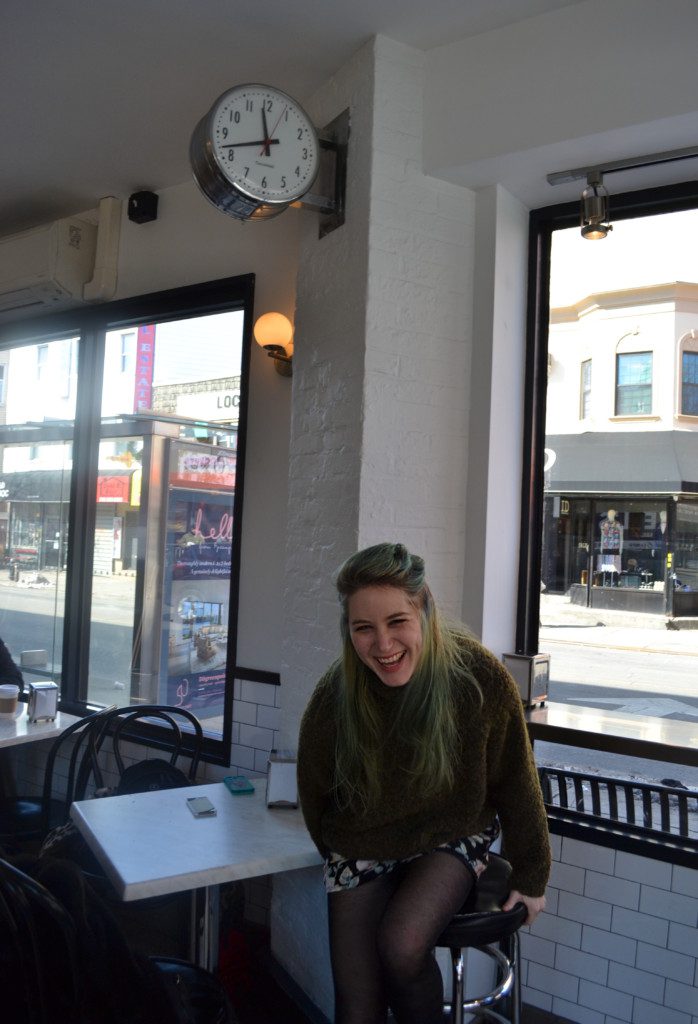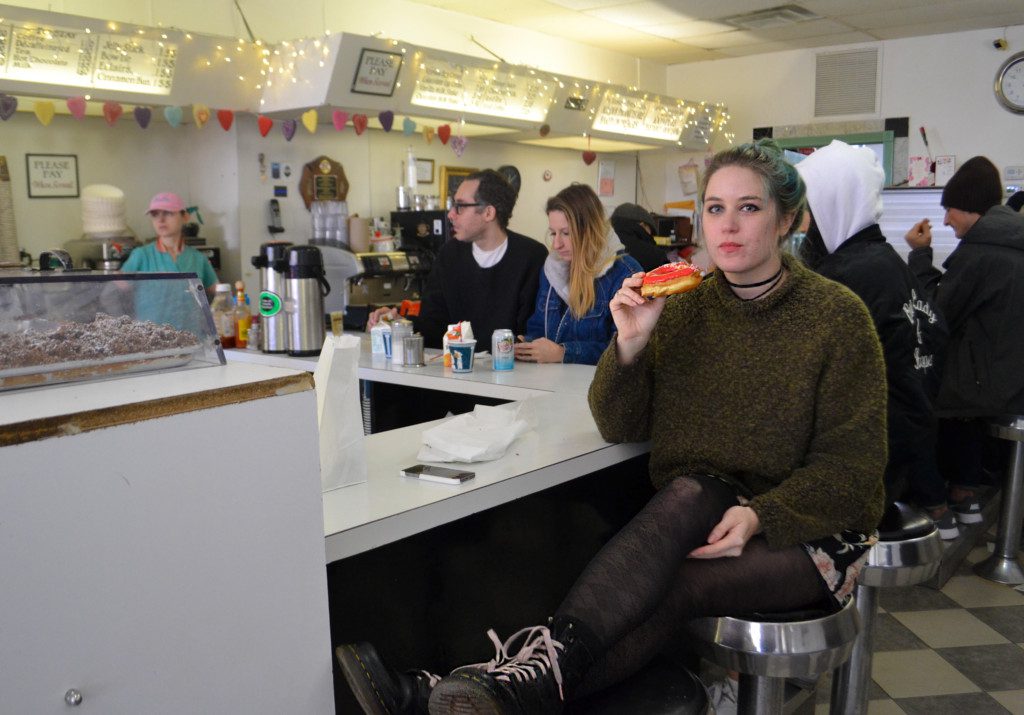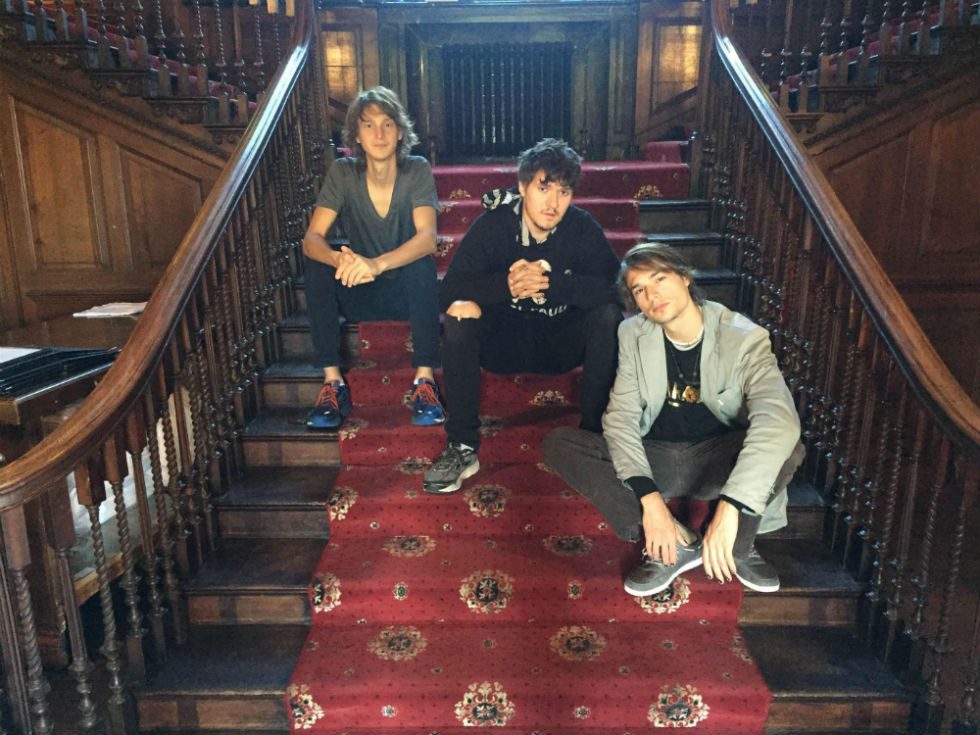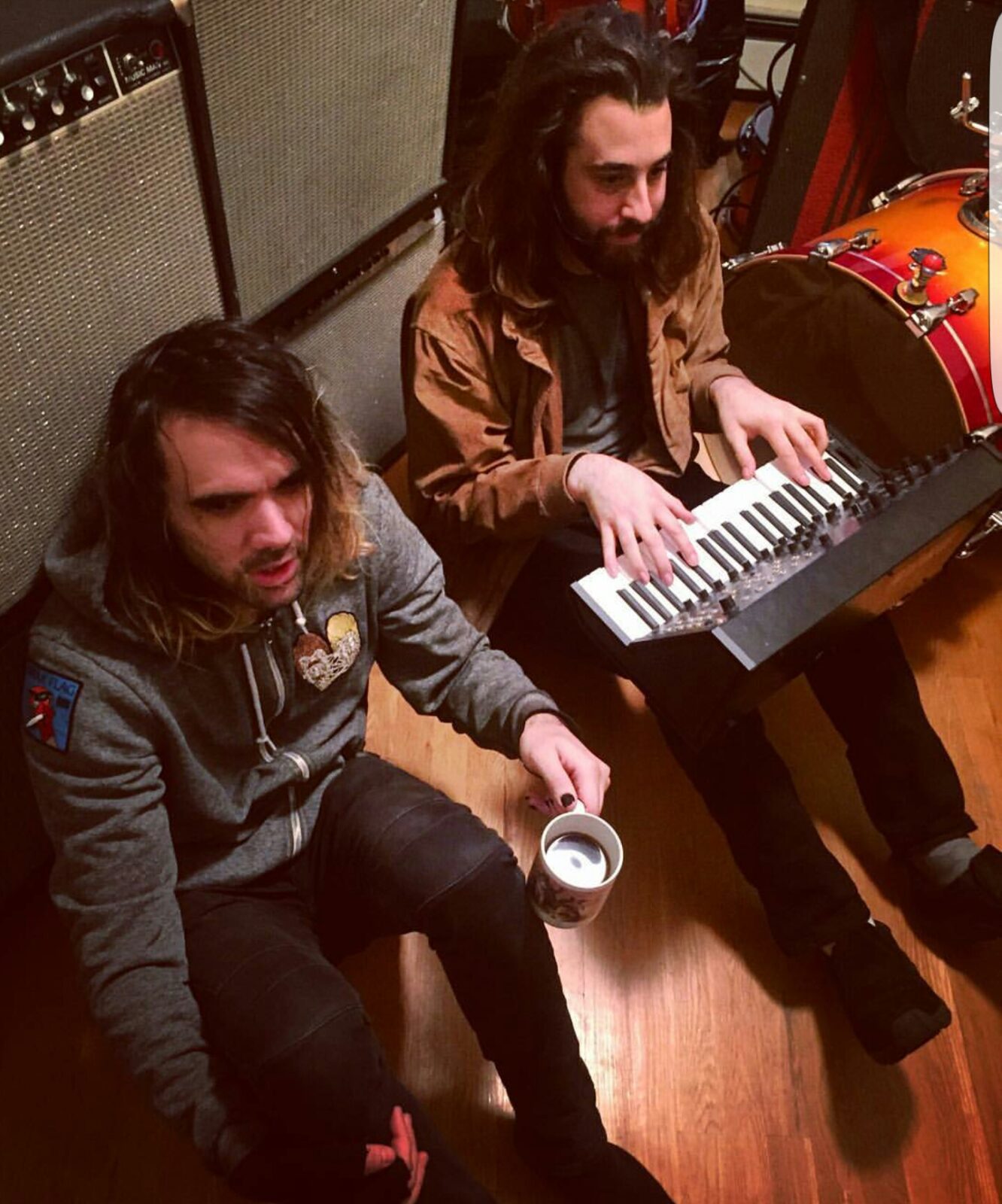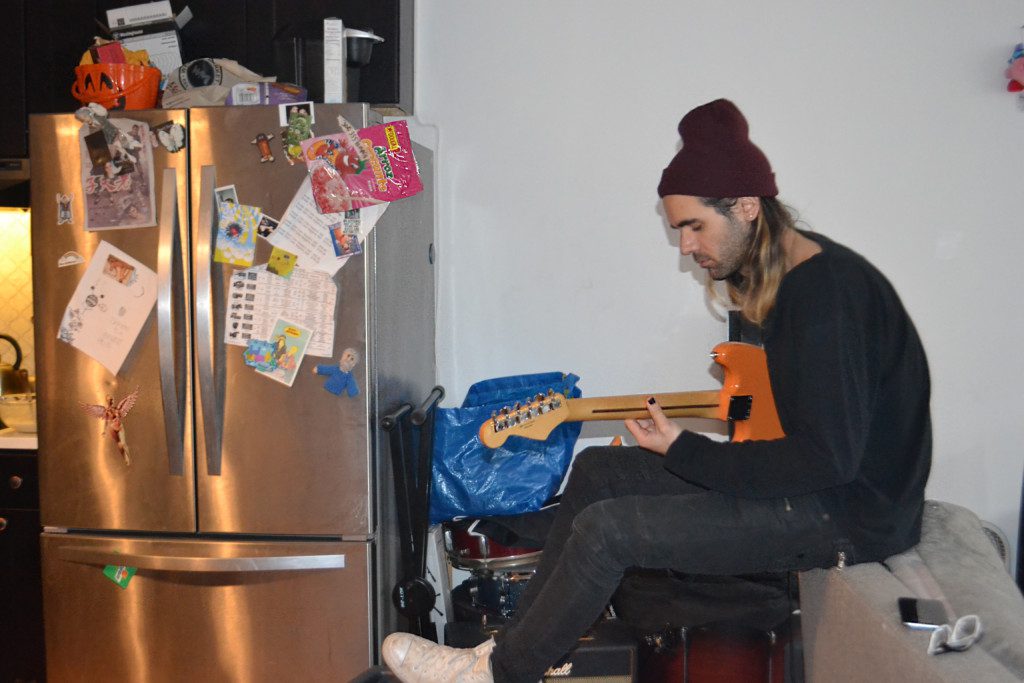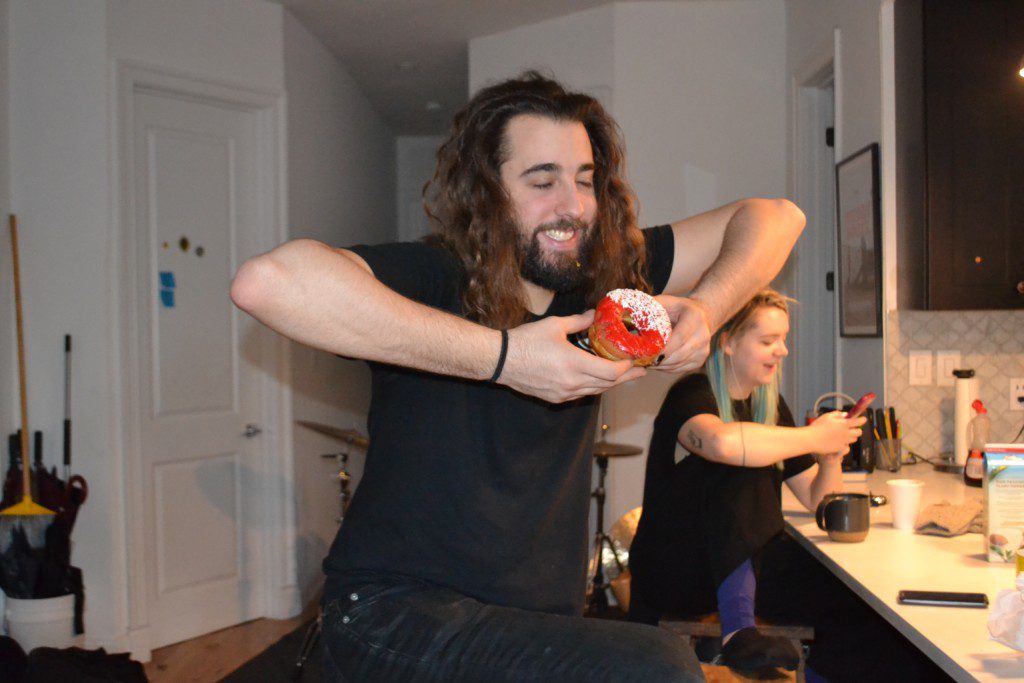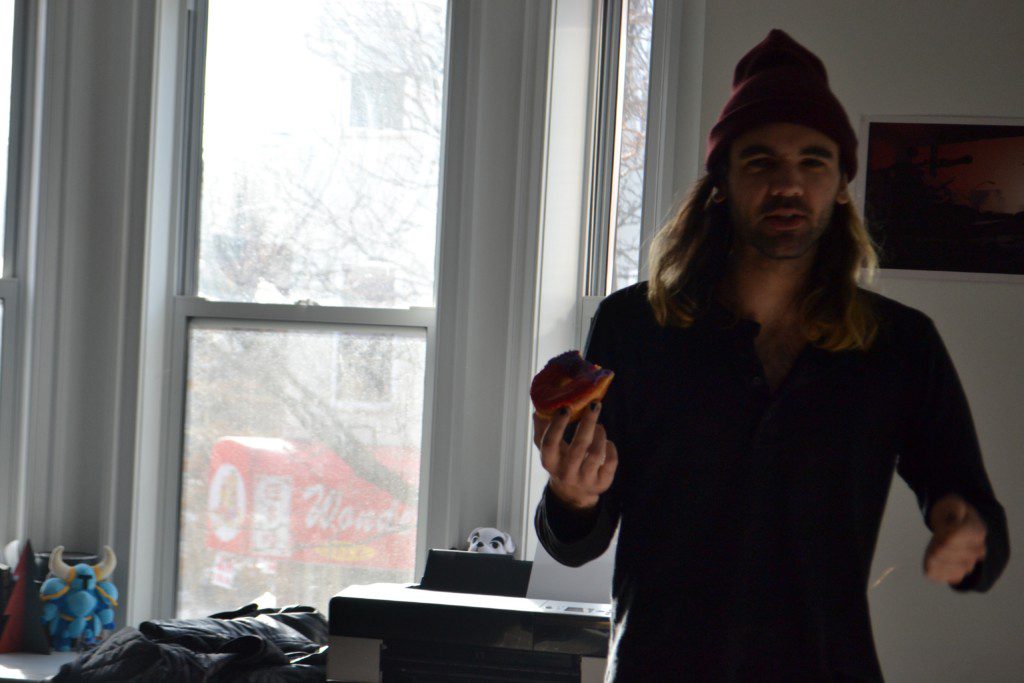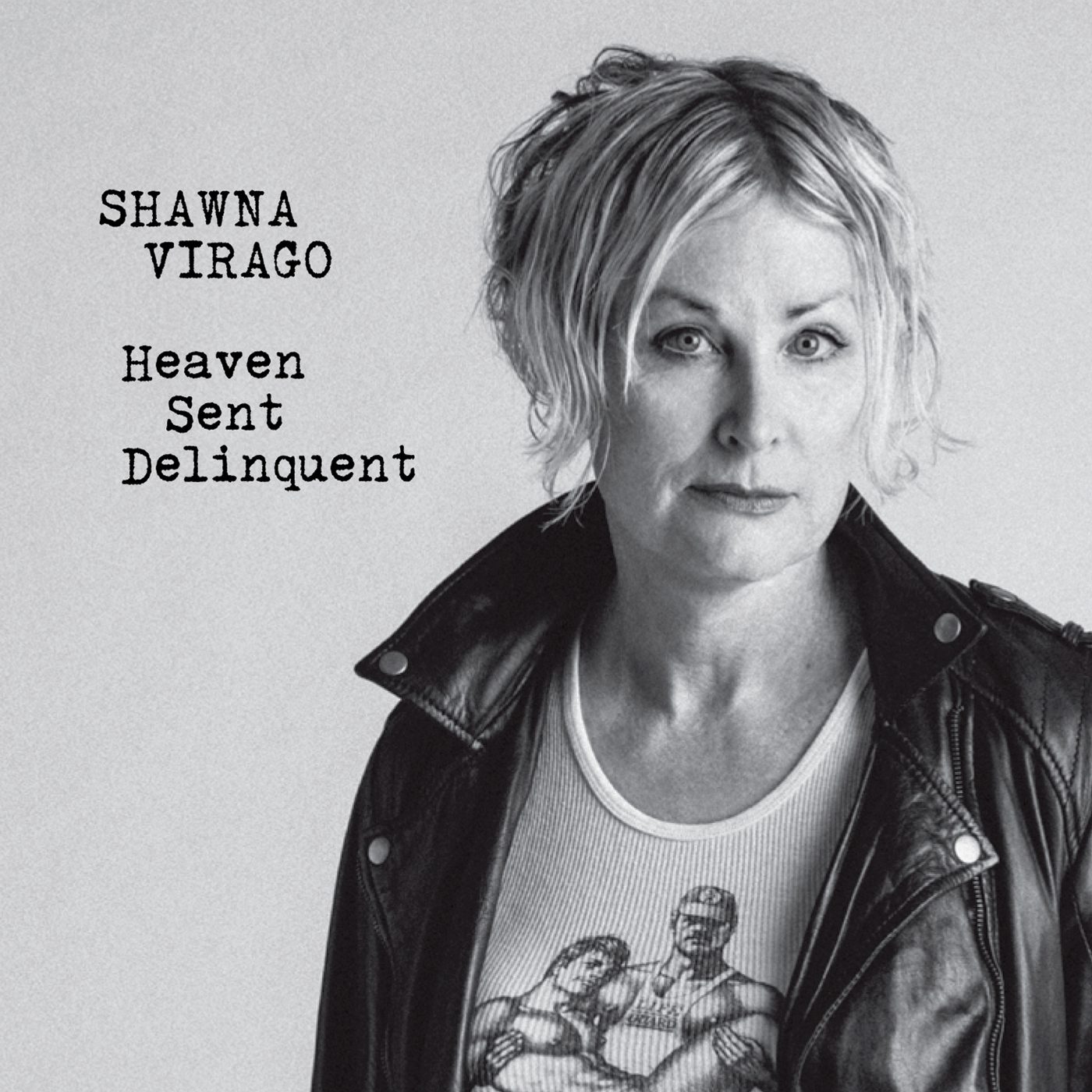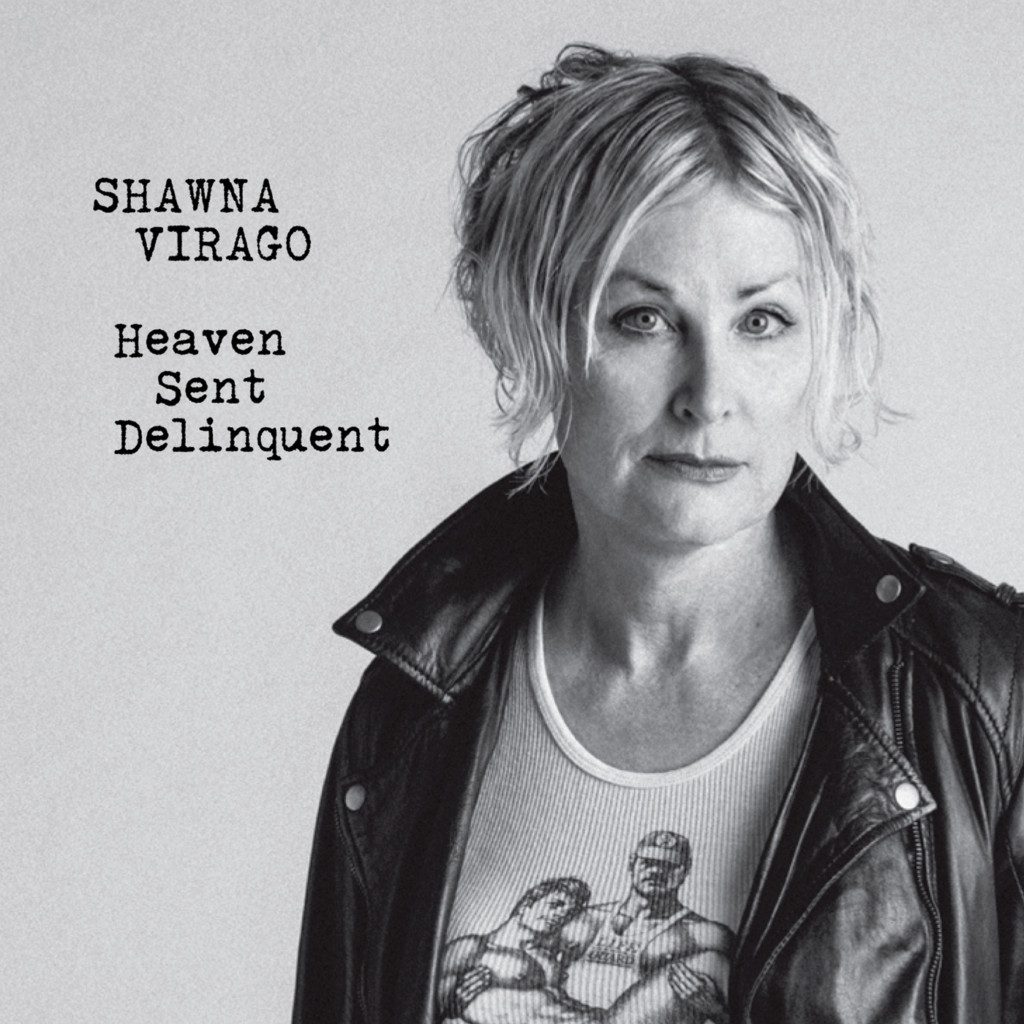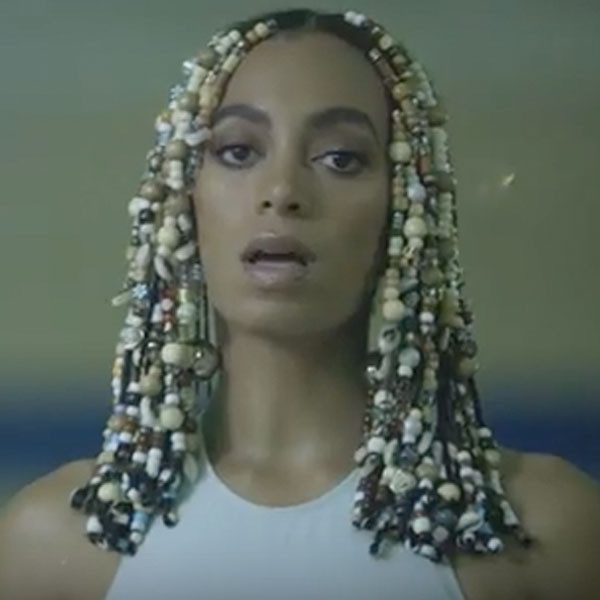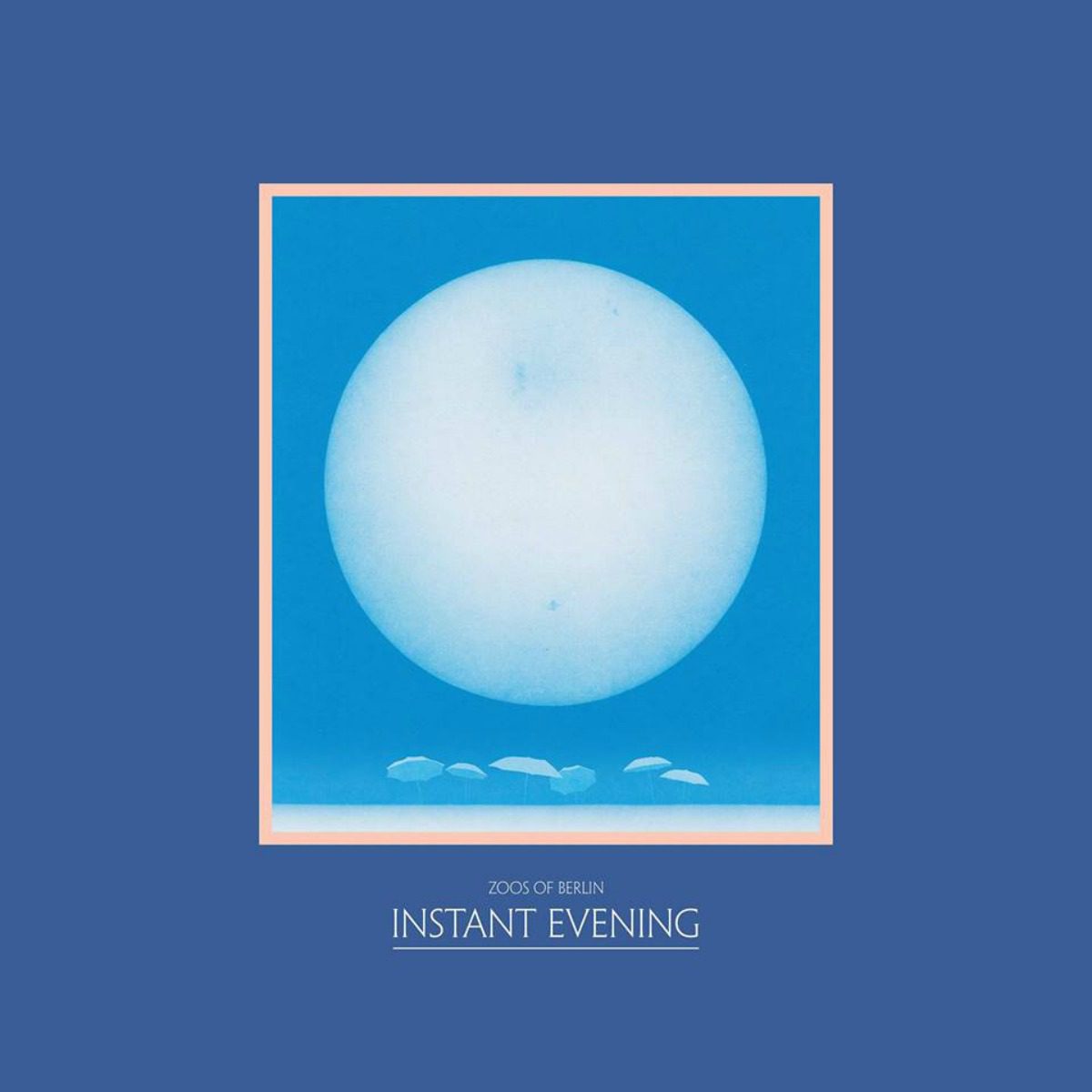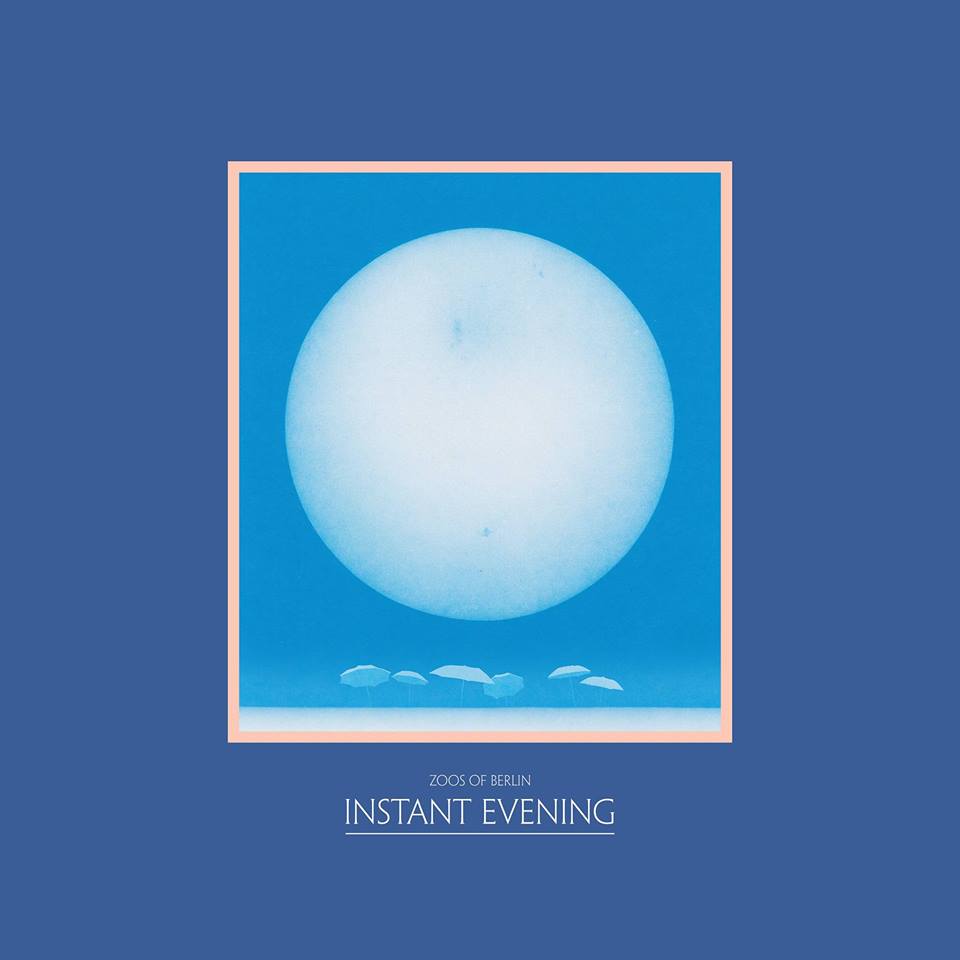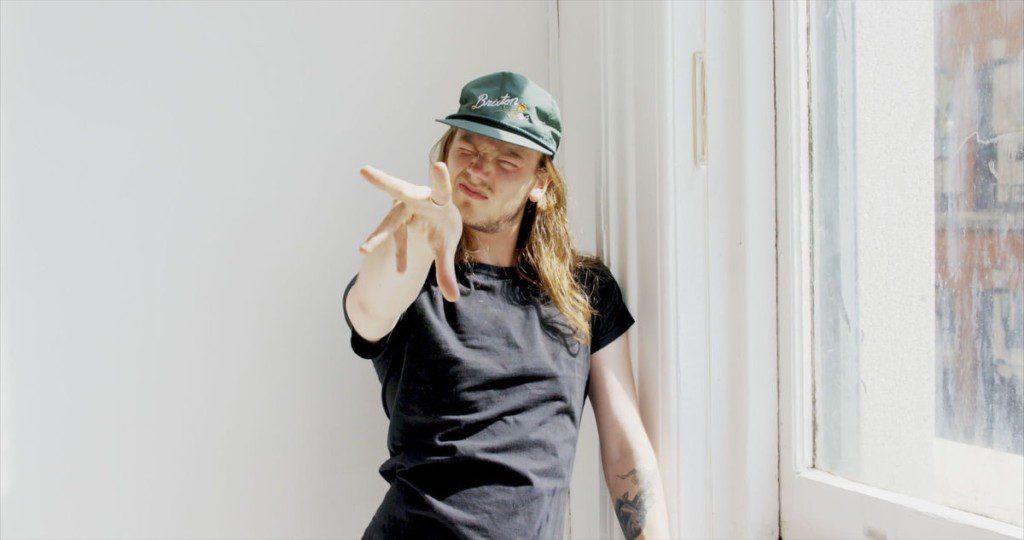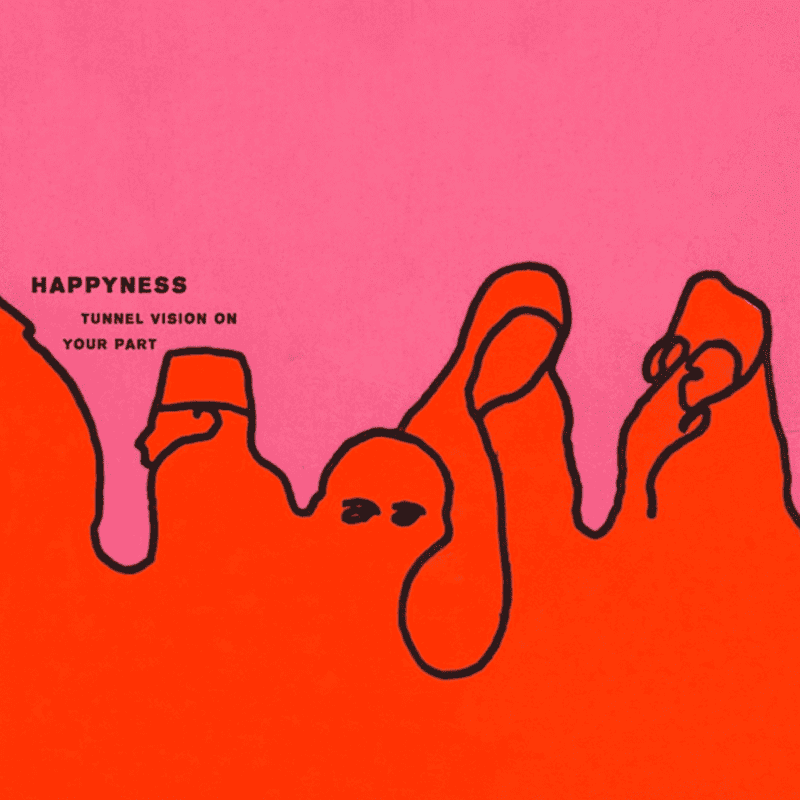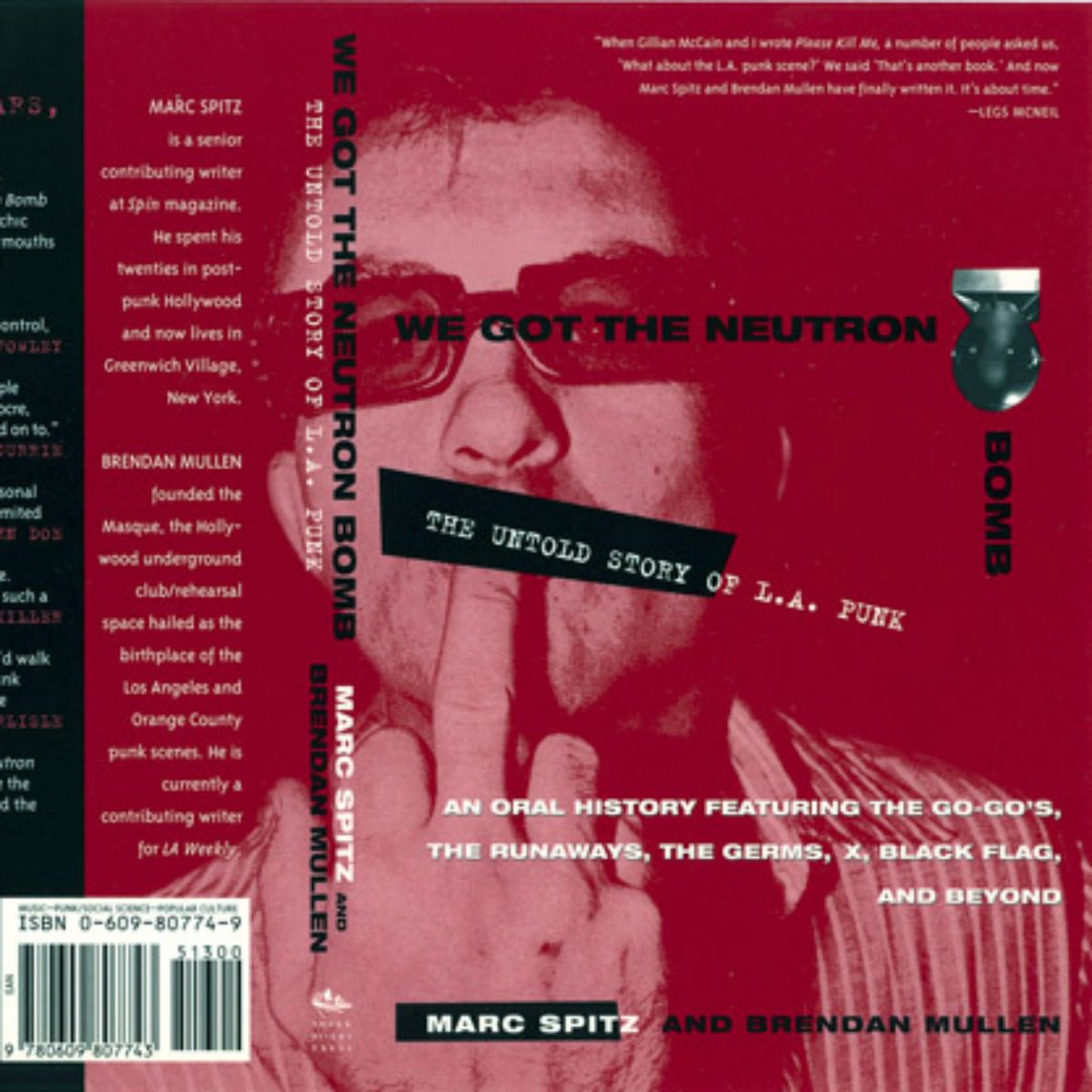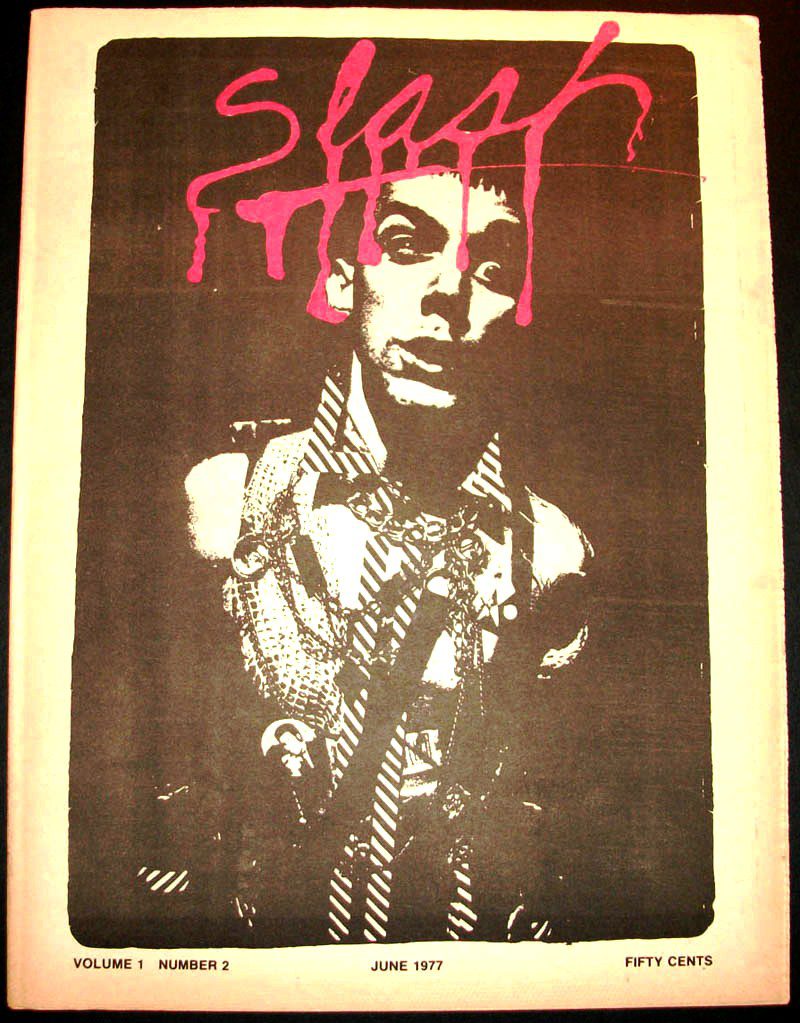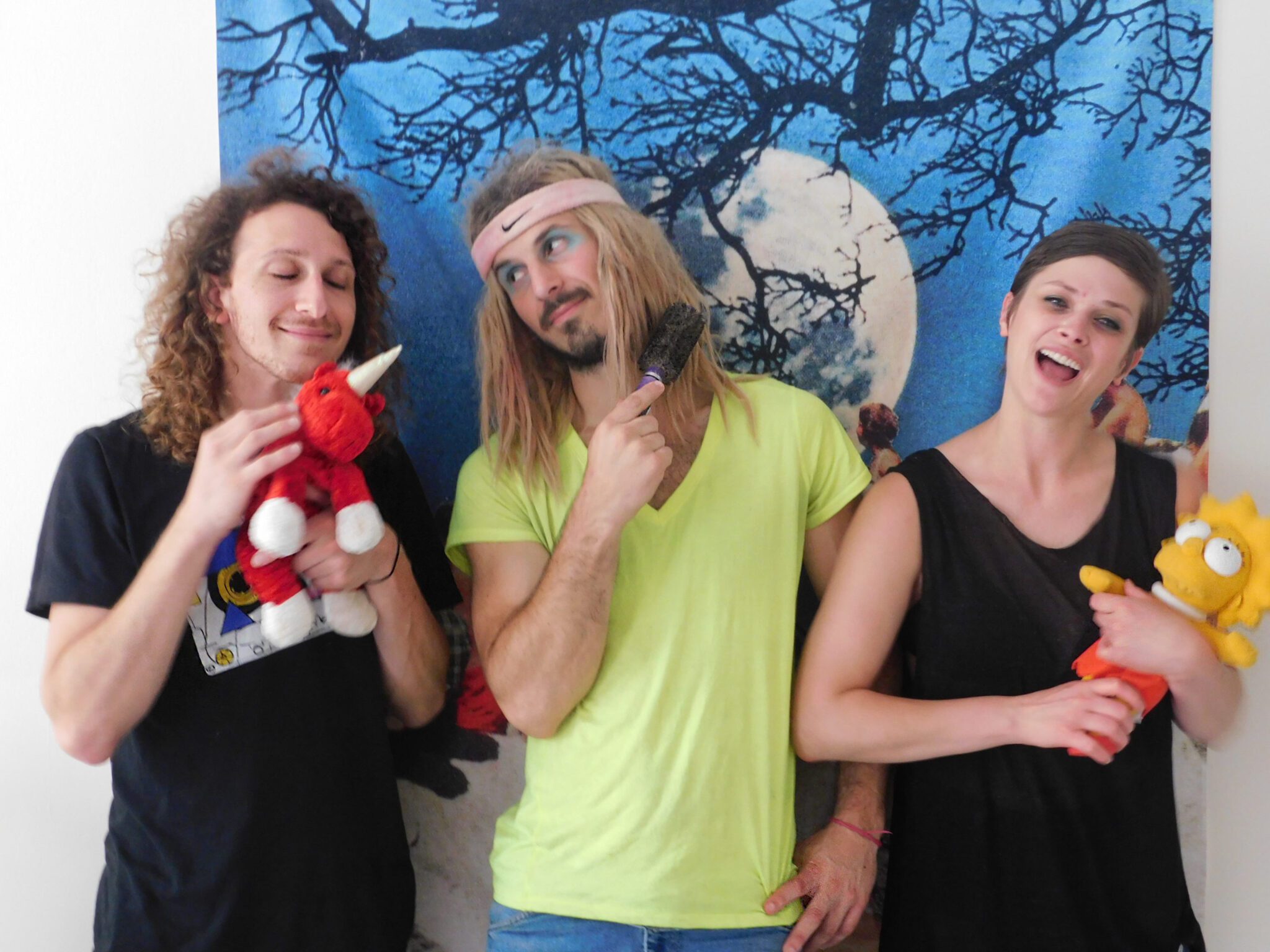
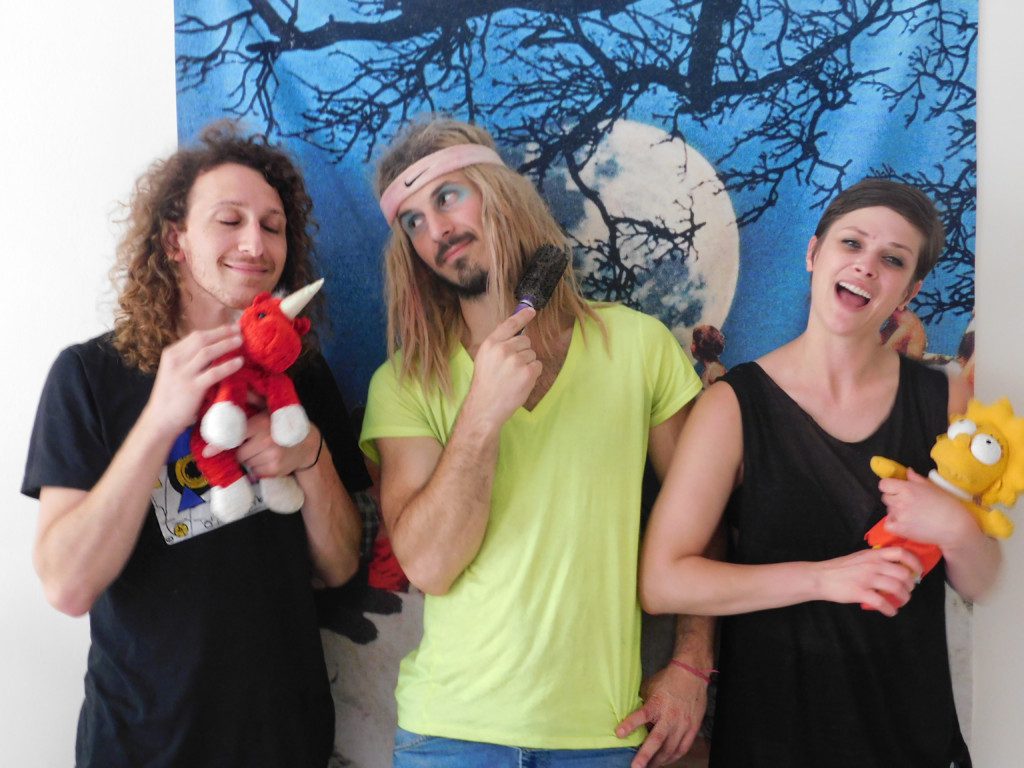
“I can’t really talk, I’m having brunch with…” I play with my platinum blonde wig and tug the string of my leopard print bikini top while addressing the poor Fios representative at my door. “…clients right now.” Behind me Mark Brickman and Hannah Teeter are picking out our audio-video entertainment (the Go-Go’s are a must, Metalocalypse is a strong contender, but they’re considering all my Buffys) and behind them Craig Martinson is unloading my cabinets. Saturday morning breakfast at my apartment; it’s every guys’ fantasy, and some guys’ very disorienting reality.
But they aren’t guys, they’re Def.GRLS.
Again, that includes Craig (guitar, brought the King’s Hawaiian Sweetbread Rolls, eggs, and syrup) Hannah (drums, brought the Shiny Ruby RedBird beer) and Mark (bass, brought the sriracha and his sparkling personality). And despite the very romantic sitch of this being my apartment/me being half-naked, I targeted Def.GRLS because they are fun AF. Swirling, maddening, neon, glitter-smeared, fun.
What’s funny is that you can actually hear a retro element in their songs. Craig and Mark pair high-pitched harmonies a Beach Boy would be proud of. “FinGRLess Lady” sounds like forty chopped-up Beatles songs smashed back together (is it? Maybe?) AND YET, Def.GRLS is down to tailspin into complete musical psychosis. Surf riffs turn into disco beats and marry robotic overlays, and that’s just in the mouthful of a song, “The Four Horsemen of the Acapulcolypse (War, Famine, Pestilence and Dance).” But while there’s audience awe, there’s never bafflement, just a resounding feeling of “Yaaaaas.”
So I’m bikini-clad with the wonderful Def.GRLS because when the seasons heat up, I prefer to have fun then fall in love.
That’s always my plan, anyway.
The Scene: When we’re scheduling this at Union Pool Mark asked if I come over and make them breakfast, and Craig stressed, “We make her breakfast.” I didn’t correct this, because I am a strong, independent woman who likes having people feed me and do my dishes.
Anyway, we’re at my McGolrick Park-side apartment, which is very Kate Spade-meets-pop-art-meets-pop-culture-meets-clinical depression.
2:51 Charly Bliss’s Guppy is already in my record player so we play side A as a prequel to Metalacalypse-Go-Go’s. Hannah and I are sharing her e-cig (read: I took it from her; I have boundary issues) and among chit-chat about Adam West and teeny mags she explains, “I’m new to the vape pen. Douchebag, what a douchebag,” she rolls her eyes (metaphorically) at the idea. “I haven’t had a fire cigarette in like 33 days, and I was smoking like a pack a day. And this is like…I don’t know. I feel better. It’s crazy. But also everything smells so bad all of a sudden.”
What she’s smelling is New York in heat, but I get the feel. “When I was smoking Njoys religiously I was like, this isn’t a real cigarette, I’m just a fucking asshole,” I confess. We decide to check on the boys who insist we don’t lift a finger, and to get breakfast-ready Craig puts on his matted blonde stage wig.
“Now we’re making breakfast.” “Now we’re making breakfast.” Mark and Hannah overlap each other before we all cheer at this transformation.
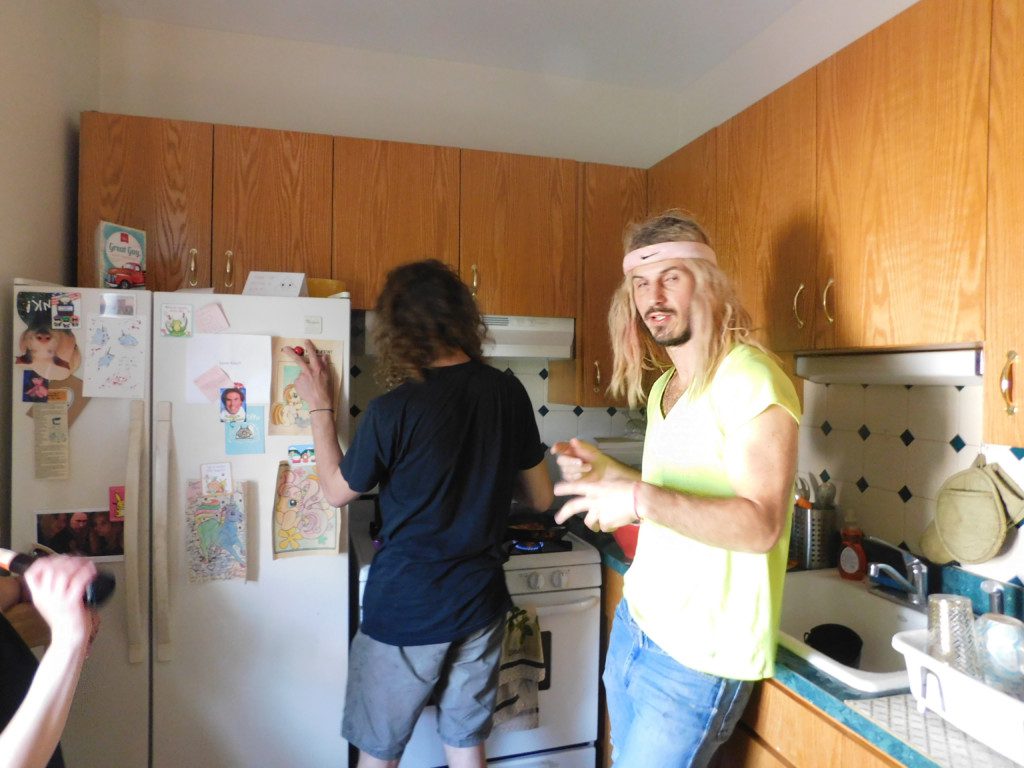
“Dude, that wig looks like it’s had some adventures,” I observe. It has.
“For our record release I had a batch of fake blood. I dumped it all over myself,” Craig says. “So every time I sweat at the show I end up stained red. Worth it.”
“Definitely worth it,” Mark echoes.
“You guys are like the funnest band,” I say.
“You are!” Mark shoots back
“I am not the funnest band,” I take a sip of my beer. “That’s just fake.”
3:19 While Mark (unsuccessfully) tries to teach me how to open a beer bottle with a lighter, we compose a Mad Lib. Hannah has the job of reading it back to the group.
“This Mad Libs is called, ‘I Do, I Dance.'” She says. “‘You’re sure to find hairy dancing at wedding receptions. There’s something very special and pubically touching when the bride and dick have the first dance and husband and wet fart.'”
Mark: “Yes, yes.”
“’And doesn’t the father-sadist dance always bring tears to your mega dick?‘”
Mark: “For sure.”
Craig: “Yeah.”
“‘But when the DJ starts playing sexingly the wedding classics, that’s when the orphan fun begins. Who doesn’t love the chicken dance, when you poke out your uvulas and flap them around?‘”
Mark: “YES, YES, THAT’S GENIUS.”
Craig: “That’s actually what it is.”
Mark: “It is now.”
“‘There’s the conga line, where you grab someone by the jumbo dicks, fall in line, and snake around Mary Grace’s house.'”
Mark: “YES, YES.”
“‘The hokey-pokey’s great too. You put your right butthole in, you put your right butthole out, you put your right butthole in and you twerk it all about.’”
Craig: “Yes.”
Mark: “Twerk it all about, that’s exactly right.”
“That is how you twerk,” I think. “‘Yes, wedding receptions are where it’s at. Just don’t get so caught up shaking your groove twerk-jerk that you forget to eat a super groovy piece of wedding chunks-blown.'”
More cheers erupt, as we’re all very proud of our verbal Frankenstein.
3:25 The phenomenal Vacation is on, the coffee’s done brewing, and I’m explaining my family tradition of making vomiting noise whenever I pour milk out of a cow creamer. They’ve also selected mugs that speak to each of them on a soul level: Hannah went with the (millennial?) pink mug with the skull and crossbones, while Mark settled on the timeless and elegant piggy mug. And Craig?
“I chose the ‘Queen of Fucking Everything’ mug,” He announces.
“Of course you did,” I reply. Duh.
“I thought the [fusion_builder_container hundred_percent=”yes” overflow=”visible”][fusion_builder_row][fusion_builder_column type=”1_1″ background_position=”left top” background_color=”” border_size=”” border_color=”” border_style=”solid” spacing=”yes” background_image=”” background_repeat=”no-repeat” padding=”” margin_top=”0px” margin_bottom=”0px” class=”” id=”” animation_type=”” animation_speed=”0.3″ animation_direction=”left” hide_on_mobile=”no” center_content=”no” min_height=”none”][Disney] princess mug was yours,” Mark remarks.
“It is mine, I have a Sailor Moon one, too.” I look into the cabinet. “Should I do unicorns or Ava Gardner?”
“Both,” Mark and Hannah chorus.
Cups acquired, I pour coffee and milk-vomit for the gang. Mark oinks when I pour his, which is all I ever wanted.
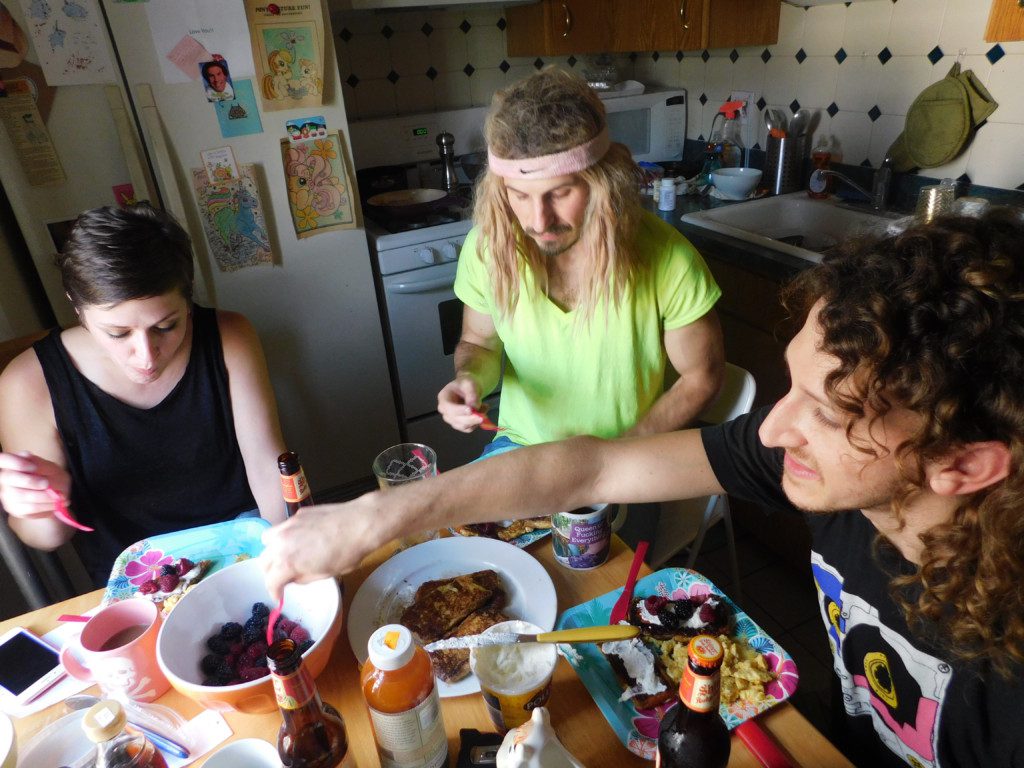
3:35 So we’re diving into this breakfast of Craig’s design, and he’s explaining how you put ricotta cheese on the french toast first, then fresh raspberries and blackberries, and then top it off with syrup. Tl;dr it’s like taking your taste buds to Disneyland.
BUT ANYWAY, our talk turns to how excited we are about their gig at the GP Stripes Northside Showcase tonight.
“Dude, it’s going to be the best. It’s all my faves. Holy Tunics!” Mark says.
I nod.”Fucking Holy Tunics and then Sic Tic closing it out.”
“Sic Tic! I love Sic Tic.” Mark says (legit everyone’s reaction when I mention Sic Tic).
“They’re so good, they’re so friendly,” Hannah adds.
“They’re good people,” Craig says. “We had two shows back-to-back, they saw us by chance, and they were like, ‘Oh you guys are playing tomorrow night? We’ll come.’ And they did.”
“And nobody ever comes when they say they’re going to come! I was like, ‘WHO ARE THESE PEOPLE?'” Hannah throws in before my phone starts to buzz.
“OH, I’m gonna talk to my dad real quick,” I say, excusing myself from the table as Hannah calls, “Hi, dad!” after me.
3:50 Hannah’s talking about her upbringing in Kansas when Mark quips, “We’re not in Kansas anymore.”
“Good one Mark, that’s really funny,” Hannah deadpans.
“I just made that up,” Mark says. “I’m a joke-writer in my free time.”
“You’re on the Jimmy Fallon team,” Craig confirms.
“All the hits,” Mark tables back.
“Name one.”
“Drew Carey.”
“You wrote for a sitcom?”
“Back in my earlier years.”
“You were like 12?”
“All the funny jokes are mine. All the not funny ones were that other guy.”
“Mark wrote Mimi.”
Hannah interrupts their ping-ponging with, “Mimi is what my parents called me when I was in seventh grade and learning how to do my make-up.”
“I think you should bring that back,” Craig says. We decide, instead, to do a Mimi-inspired look for Craig to wear to the showcase tonight. Luckily I have sapphire eyeshadow in droves.
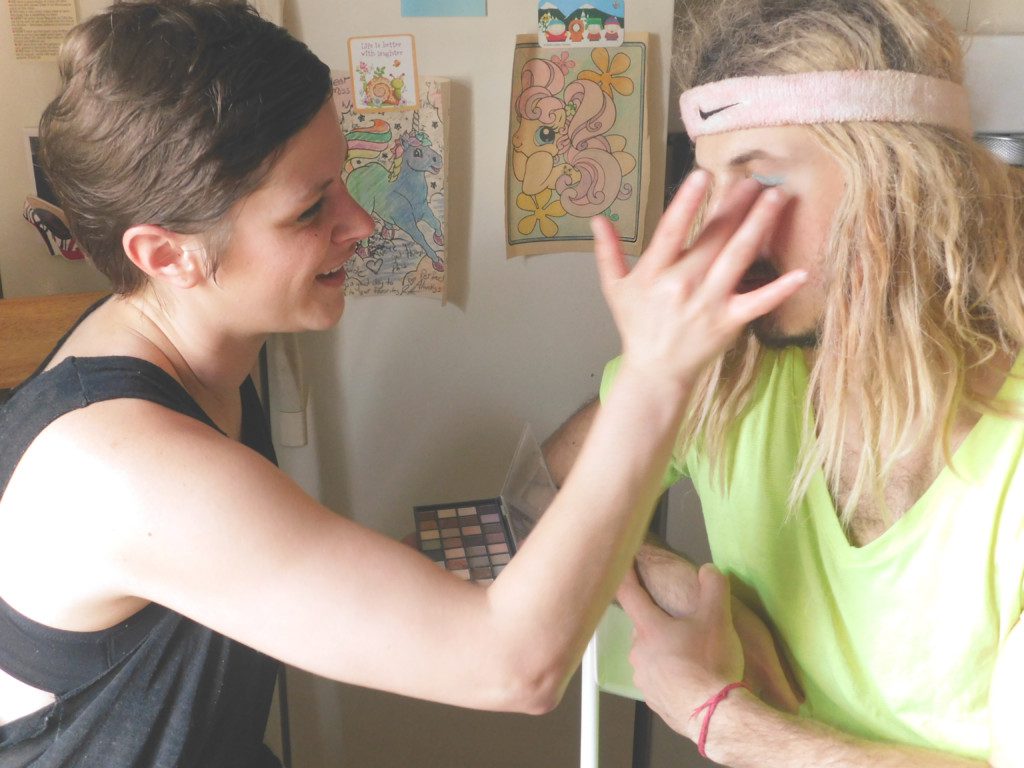
3:59 After I make the switch from Vacation to Beauty and the Beat, I realize how much noise we’re making, and how my Ukrainian landlady can probably hear every horrifying conversation. “But it’s the middle of the day. There’s nothing I’m technically doing wrong, except, like, cooking,” I shrug.
All the while I decide to let my social media feed know that I’m still having fun, so I start composing a status before I need to be a journalist and fact-checker.”Wait, how do I spell Def.GRLS? GRLS is capitalized, right?”
“There’s a period in the middle, no space. We were actually like ‘how annoying do we want to make this’? We decided on maximum,” Craig says. “There’s no vowels, there’s punctuation, GRLS is all capital, it’s very specific.”
“We get so mad when people spell it wrong,” Mark says.
“Well, that’s our job,” Craig replies.
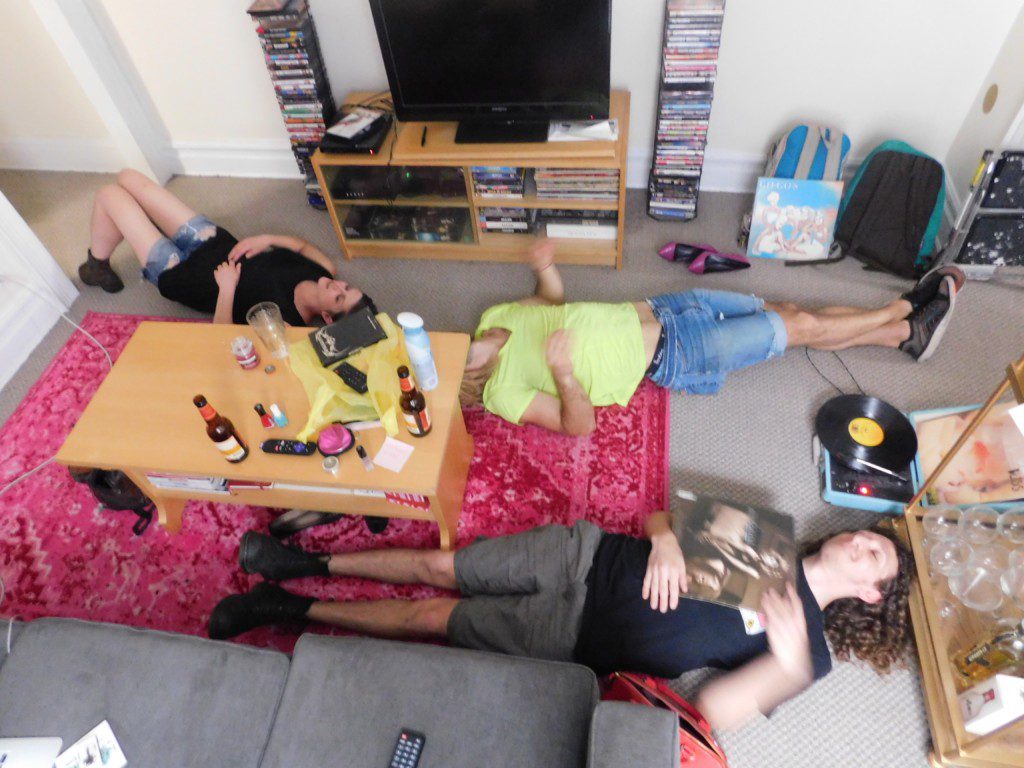
Def.GRLS and I end up separated for an exhausting 5 hours, reuniting (as promised) at their Northside gig, where they brought the madness full force. Partying ensued. But around 2 am I impulsively decided to Irish exit (incidentally leaving Mark with my phone charger). As I stumbled down the street I received a Facebook message from Craig saying that he was sorry they forgot to give me a shout out. But they did write me this song:
Mary Grace
I ate breakfast at your place
Put your makeup on my face
Mary Grace
I had to leave your embrace
For our practice space
Oh dear, oh god, oh no, we’re all going to fall in summer love. Can’t you feel it?
You can stream Def.GRLs on Soundcloud or Bandcamp, and party with them anytime.[/fusion_builder_column][/fusion_builder_row][/fusion_builder_container]
